Spiders are among the most fascinating creatures in the animal kingdom. Found almost everywhere on Earth, these eight-legged arachnids come in a wide range of shapes, sizes, and colors. Some are harmless and helpful pest controllers, while others have venom potent enough to capture large prey—or even scare humans. In this identification guide, we’ll explore 50 different types of spiders from around the world, helping you recognize them by their looks, habitats, and unique behaviors.
1. Black Widow Spider (Latrodectus mactans)
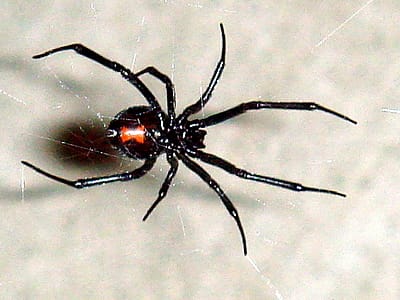
The Black Widow Spider is one of the most famous—and feared—spiders in the world. Recognizable by its shiny black body and distinctive red hourglass marking on the abdomen, this spider belongs to the genus Latrodectus. Females are larger than males and are the ones known for their potent venom. Despite its reputation, a Black Widow bite is rarely fatal to humans, thanks to modern medical treatment. However, it can cause severe pain, muscle cramps, and sweating.
Black Widows prefer dark, undisturbed areas such as woodpiles, sheds, or basements. They build irregular, tangled webs close to the ground where they trap insects and other small arthropods. Interestingly, the spider’s silk is one of the strongest among arachnids—five times stronger than steel of the same diameter. In the wild, they help balance insect populations and rarely show aggression unless provoked.
These spiders can be found throughout the Americas, southern Europe, Asia, and Australia. They are solitary and nocturnal hunters, coming out mainly at night. While their intimidating appearance and venom make them infamous, they play a vital role in maintaining ecosystem balance.
2. Brown Recluse Spider (Loxosceles reclusa)
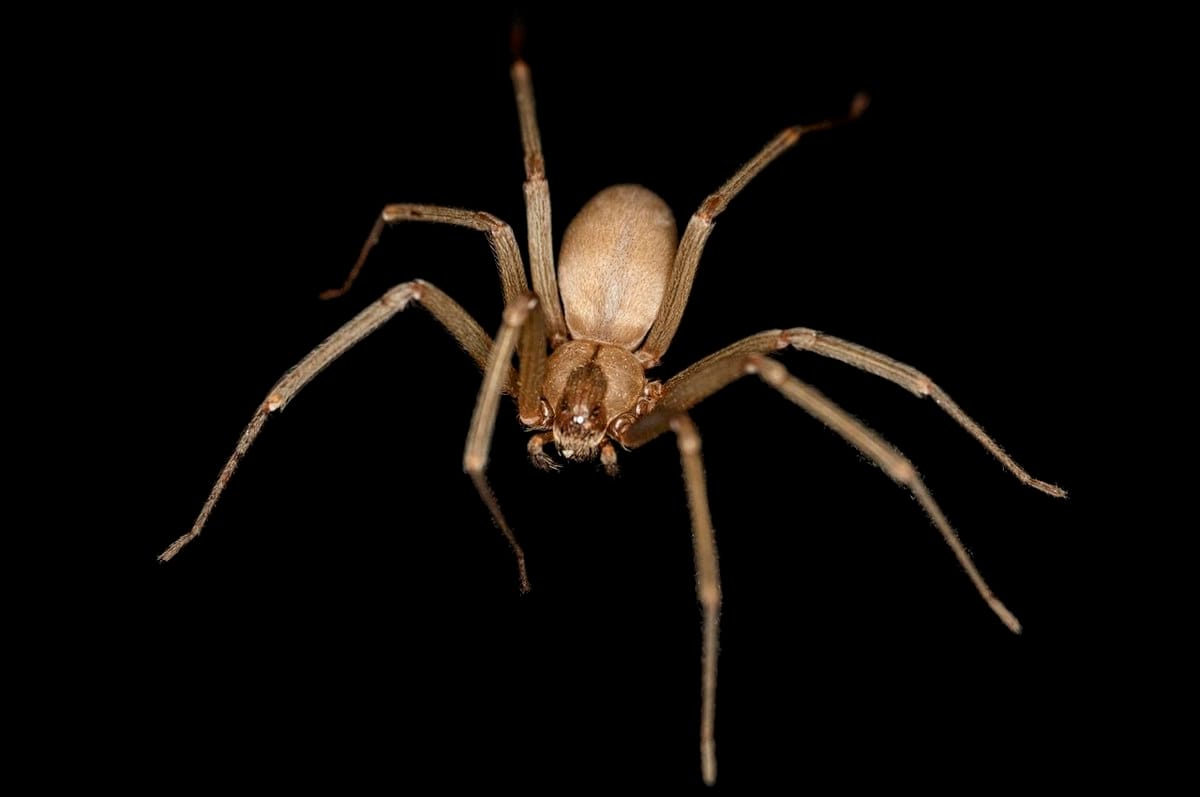
The Brown Recluse Spider is another well-known species, particularly in North America. It can be identified by its violin-shaped marking on the cephalothorax (the body section near its head). Typically light to dark brown in color, this spider’s body is about 1/4 to 1/2 inch long, with legs extending up to an inch.
As the name suggests, Brown Recluses prefer to live in quiet, undisturbed places like closets, attics, and under furniture. They are nocturnal hunters, feeding on soft-bodied insects such as moths, cockroaches, and crickets. What sets them apart from many spiders is that they have only six eyes arranged in pairs—most spiders have eight.
Though their venom is medically significant, bites are uncommon and usually happen when the spider is accidentally pressed against human skin. The venom can cause tissue necrosis in rare cases, but most bites heal with proper care. Despite their fearsome reputation, Brown Recluses are shy and prefer to stay hidden rather than confront humans.
3. Wolf Spider (Lycosidae family)

Wolf Spiders are agile hunters that rely on speed and eyesight instead of webs to catch their prey. Belonging to the family Lycosidae, they are found on every continent except Antarctica. Their appearance is rugged—hairy bodies, long legs, and camouflaged brown, gray, or black coloring that helps them blend into their surroundings.
Unlike many spiders, Wolf Spiders carry their egg sacs attached to their spinnerets. After hatching, the tiny spiderlings climb onto the mother’s back and stay there until they’re ready to live independently—a rare and fascinating display of maternal care in the spider world.
These spiders are ground dwellers and can often be found in gardens, forests, grasslands, and even homes. They hunt mostly at night, ambushing insects and small invertebrates. While their appearance might be intimidating, Wolf Spiders are not aggressive toward humans and their bite is usually harmless, causing only mild irritation.
Their keen eyesight and speed make them one of the most successful hunters in the arachnid world, and they play an essential role in controlling pest populations.
4. Jumping Spider (Salticidae family)
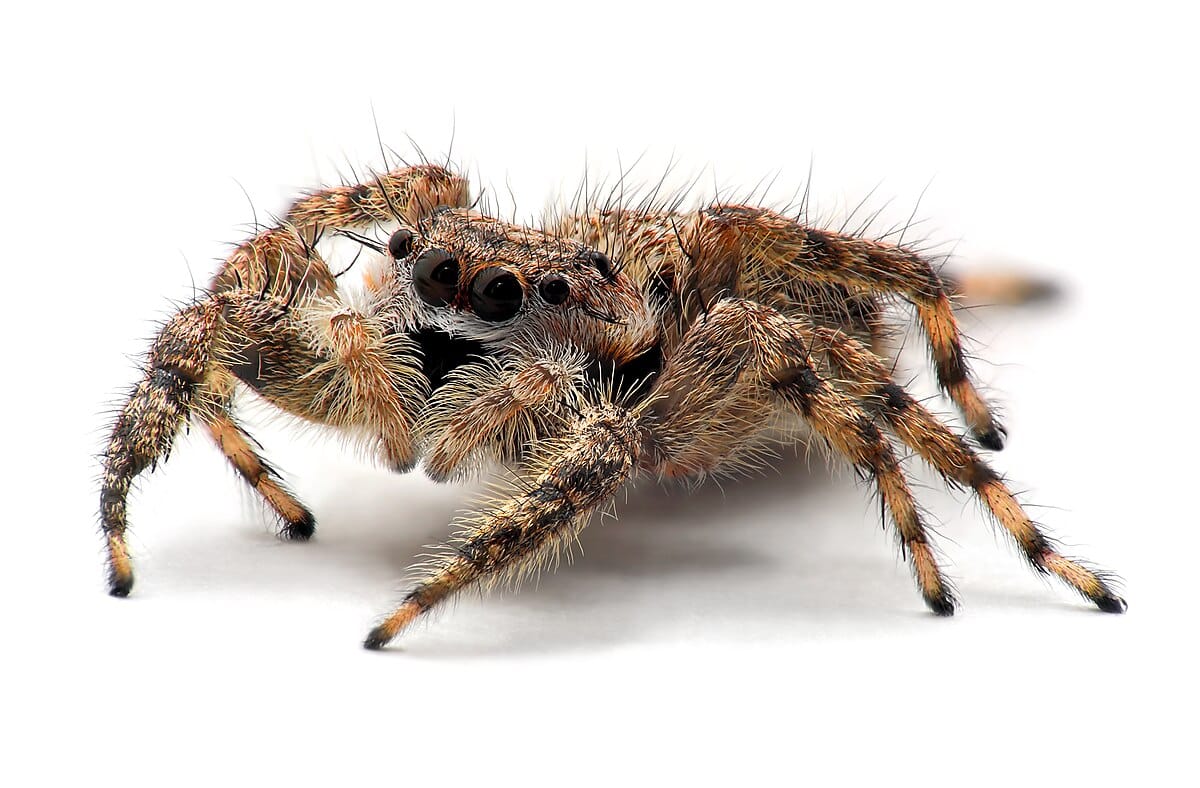
Jumping Spiders are easily recognized by their compact bodies, short legs, and large, forward-facing eyes that give them exceptional vision. They belong to the Salticidae family, the largest spider family, with over 6,000 known species. These tiny acrobats are famous for their ability to leap many times their body length—up to 50 times in some species!
Unlike web-building spiders, Jumping Spiders actively stalk and pounce on their prey. They use a silk tether as a safety line when jumping, ensuring they can climb back if they miss their target. Their behavior is curious and even “cute,” often turning their heads to look at humans with their bright, reflective eyes.
These spiders are often found on plants, walls, or windowsills, and they’re diurnal—active during the day. They feed mainly on small insects, such as flies and moths. Despite their tiny size, they’re fearless hunters and excellent climbers.
Jumping Spiders are harmless to humans and often appreciated for their playful, intelligent behaviors. Their colorful patterns and lively nature make them one of the most beloved spider groups among arachnid enthusiasts.
5. Orb-Weaver Spider (Araneidae family)
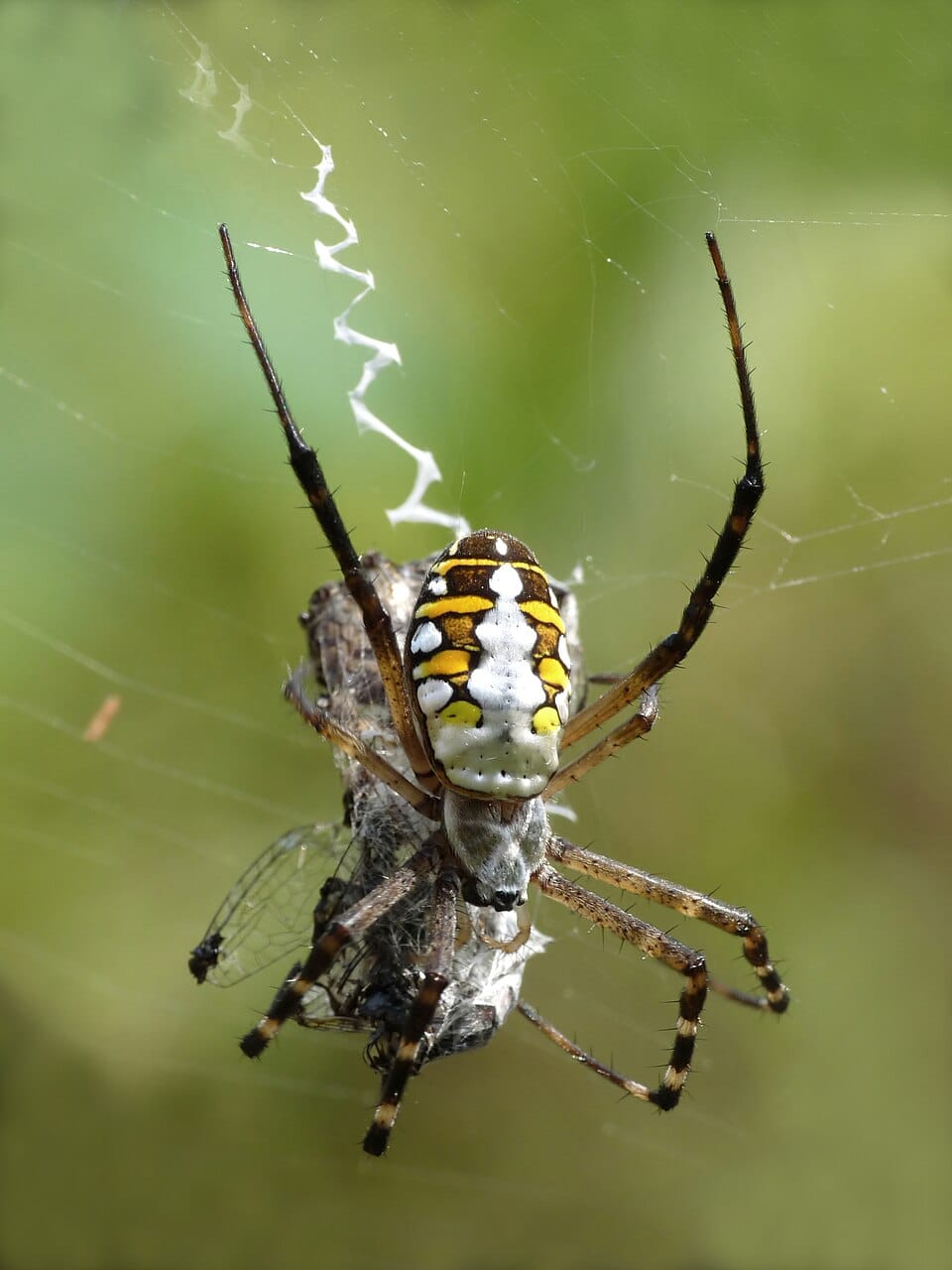
Orb-Weaver Spiders are among the most common and recognizable web-building spiders in the world. Their circular, wheel-shaped webs are works of art—beautifully symmetrical and extremely effective at catching flying insects. With over 3,000 species in the Araneidae family, Orb-Weavers vary greatly in size and color, from bright yellows and reds to subtle browns and blacks.
These spiders are mostly nocturnal and rebuild their webs each evening, recycling silk from the old one. Female Orb-Weavers are usually larger and more colorful than males. They hang in the center of their webs, waiting patiently for prey to get caught in the sticky strands. Once an insect is trapped, the spider quickly wraps it in silk before delivering a venomous bite.
Common examples include the Garden Spider, Marbled Orb-Weaver, and Golden Silk Orb-Weaver. Despite their intimidating size and striking patterns, these spiders are harmless to humans. They play a vital role in ecosystems by controlling mosquito and fly populations.
Watching an Orb-Weaver spin its web is mesmerizing—it’s a reminder of nature’s incredible engineering and precision. Their peaceful presence in gardens and forests makes them true artisans of the spider world.
6. Goliath Birdeater (Theraphosa blondi)
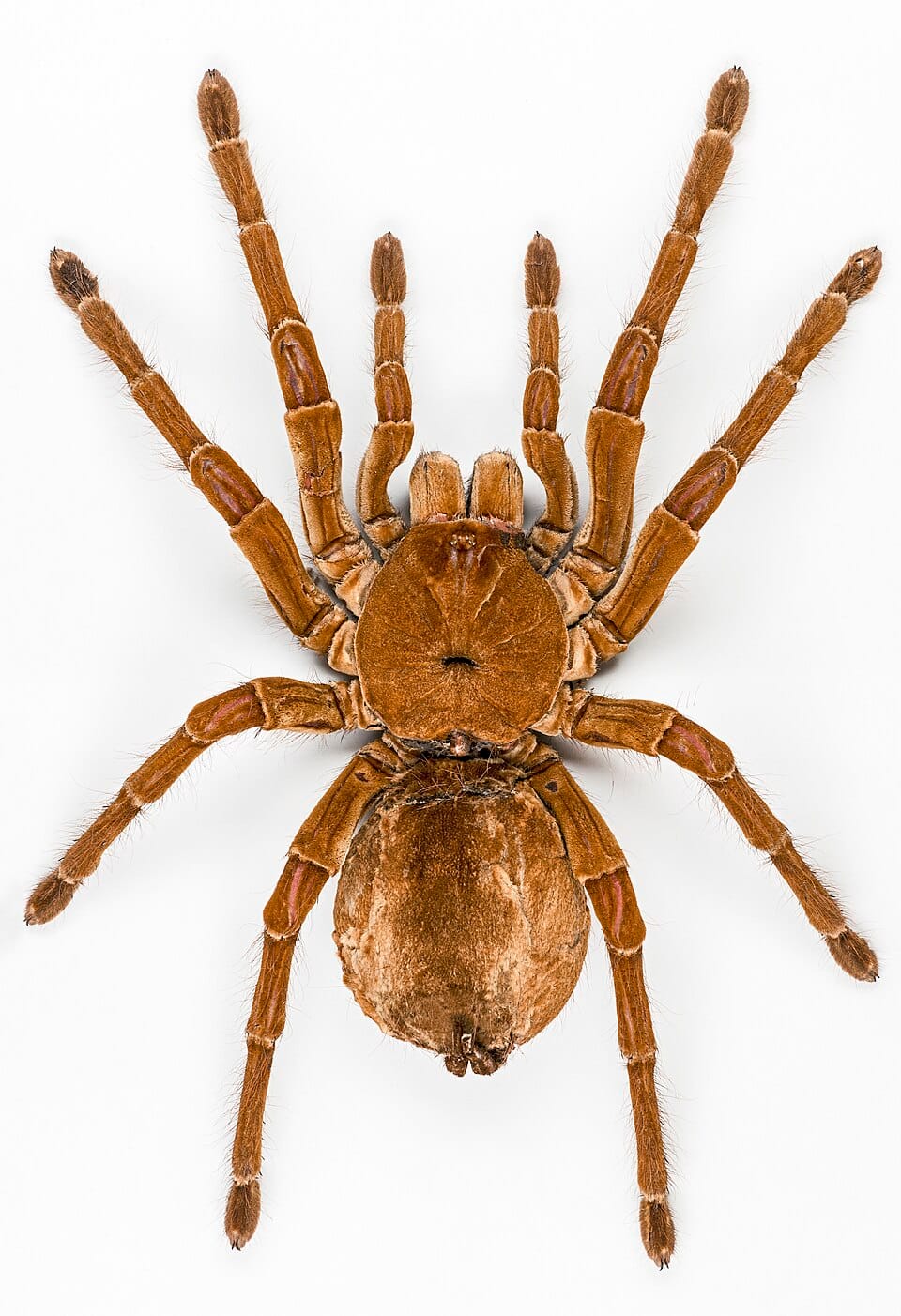
The Goliath Birdeater holds the title of the world’s largest spider by mass and size. Native to the rainforests of South America, especially in Guyana and Brazil, this giant tarantula can have a leg span of up to 12 inches and weigh over 6 ounces—roughly the size of a dinner plate! Despite its fearsome name, the Goliath Birdeater rarely eats birds. Its diet mostly includes insects, worms, frogs, and small rodents.
This spider belongs to the tarantula family (Theraphosidae) and is covered in dense, brown hair that serves as a defense mechanism. When threatened, it rubs its legs together to release tiny urticating hairs into the air, which can irritate the eyes and skin of potential predators. The Goliath also produces a loud hissing sound—called stridulation—by rubbing its legs together, warning enemies to stay away.
Despite its intimidating size, the Goliath Birdeater’s venom is not deadly to humans. A bite can cause pain similar to a wasp sting, but it poses no serious threat. These spiders spend most of their lives in burrows, emerging at night to hunt. They play a critical ecological role in controlling insect and small vertebrate populations in their rainforest habitats.
Seeing a Goliath Birdeater in person can be awe-inspiring—it’s a living relic of evolution that demonstrates just how diverse and powerful the arachnid world truly is.
7. Huntsman Spider (Sparassidae family)
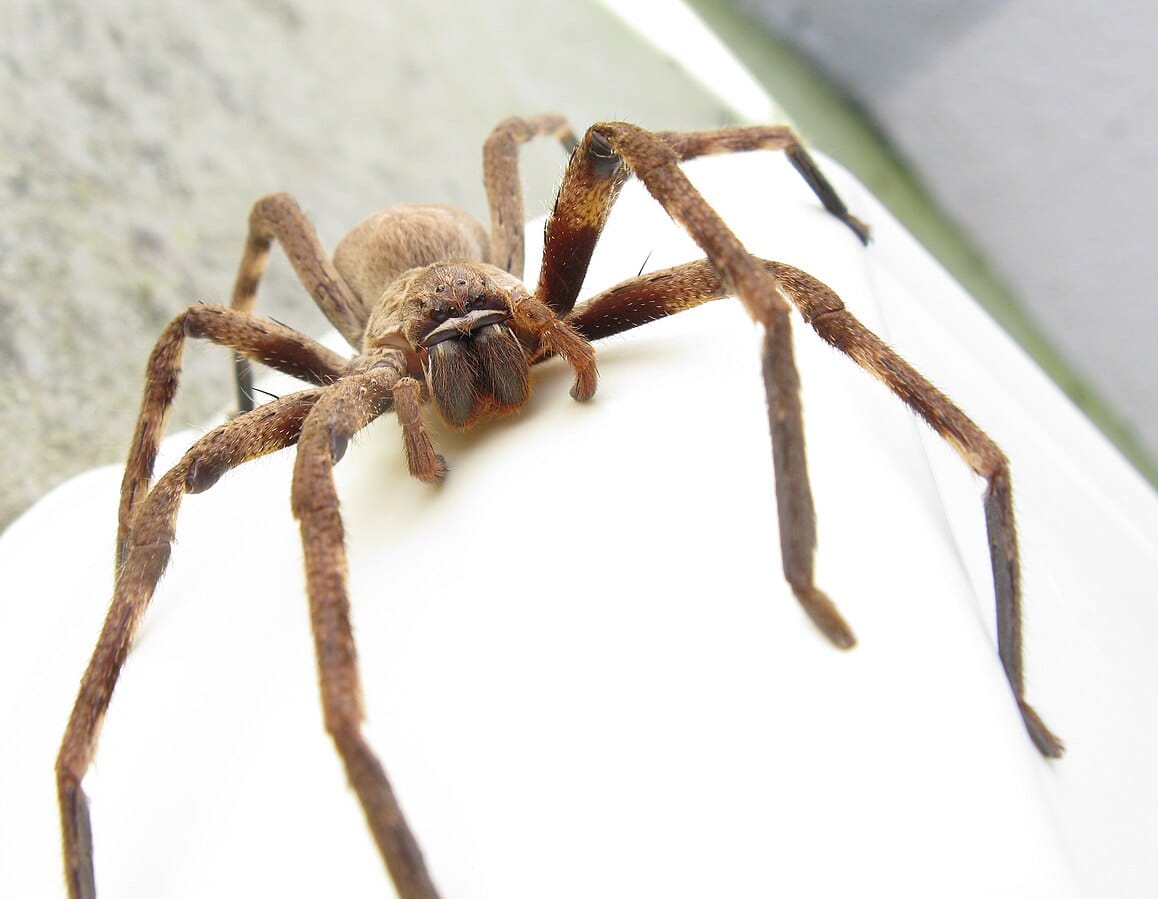
The Huntsman Spider, also known as the Giant Crab Spider, is famous for its incredible speed and long legs. Belonging to the Sparassidae family, these spiders can grow up to 5 inches in leg span and are commonly found in warm regions across Asia, Africa, Australia, and the Americas. Their flattened bodies and sideways legs give them a crab-like appearance, helping them squeeze into tight spaces like tree bark or under rocks.
Huntsman Spiders don’t spin webs to catch prey. Instead, they actively hunt insects, cockroaches, and even small lizards. Their speed and agility make them highly efficient predators. Some species can even leap short distances when chasing or escaping threats.
While their size and sudden movements can be startling, Huntsman Spiders are harmless to humans. In fact, they’re beneficial house guests that help keep pest populations in check. In Australia, it’s common to find one perched quietly on a wall or ceiling at night—startling, yes, but entirely harmless.
Their docile nature, unique hunting technique, and crab-like walk make them one of the most intriguing spider species to observe up close. They embody the wild beauty of nature’s stealth hunters.
8. Peacock Spider (Maratus genus)
If spiders could dance, the Peacock Spider would be their king. Native to Australia, these tiny Jumping Spiders—measuring just 5 millimeters long—are known for their stunning, iridescent colors and elaborate mating dances. Males display vibrant, peacock-like patterns on their abdomen, which they lift and fan out like a showy tail while performing a rhythmic courtship dance to attract females.
The Peacock Spider belongs to the Salticidae family, the same as regular Jumping Spiders, but they stand out for their beauty and charisma. Each species within the Maratus genus has unique colors and patterns, ranging from bright blues and reds to metallic greens. Scientists have discovered more than 80 species so far, each with its own “dance style.”
These spiders have excellent eyesight and an inquisitive nature. They are diurnal, meaning they’re active during the day, hunting small insects and watching the world with their large, forward-facing eyes. Despite their small size, they’ve become internet sensations thanks to nature documentaries and viral videos showcasing their mesmerizing dances.
The Peacock Spider proves that not all arachnids are scary—some are downright dazzling, blending artistry and biology in one tiny package.
9. Golden Silk Orb-Weaver (Trichonephila clavipes)
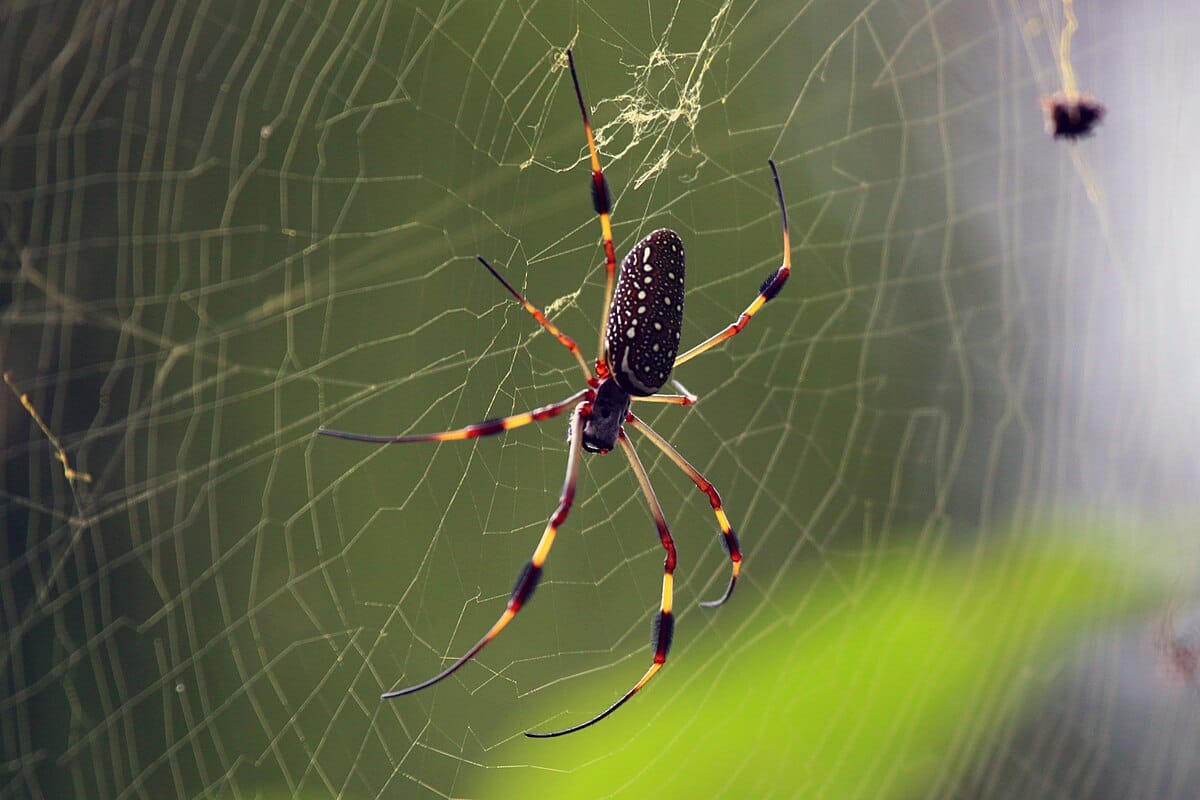
The Golden Silk Orb-Weaver, also called the Banana Spider, is famous for spinning golden-colored webs that shimmer beautifully in sunlight. Found in warm regions such as Southeast Asia, Africa, and the Americas, this spider is not only admired for its web but also for its elegant appearance—females have long, slender legs and bright yellow or orange bodies with black markings.
These spiders can grow impressively large, with females reaching body lengths of up to 2 inches and leg spans over 5 inches. Males, however, are much smaller—often just one-fifth the size of the female. The shimmering golden silk they produce is incredibly strong and flexible, once studied by scientists for potential use in textiles and engineering materials.
Golden Silk Orb-Weavers are gentle and non-aggressive. They build large, vertical webs in forests and gardens, catching flies, bees, and even small butterflies. Their webs are often reconstructed daily to maintain their strength and shape. Despite their intimidating size, they pose no danger to humans—their venom is mild and rarely causes anything more than mild itching or redness.
With their radiant webs and calm behavior, Golden Silk Orb-Weavers remind us how beauty and function coexist perfectly in nature’s designs.
10. Trapdoor Spider (Ctenizidae family)
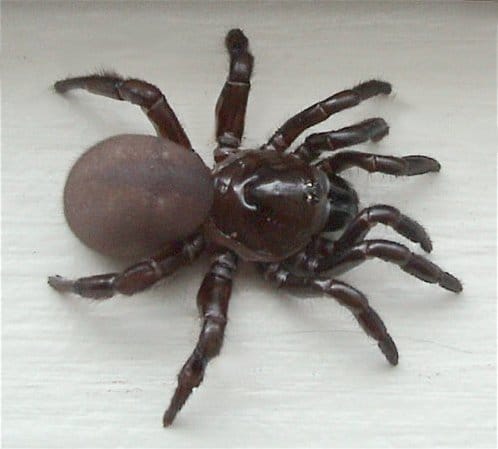
The Trapdoor Spider is an engineering genius of the arachnid world. It gets its name from the unique silk-and-soil “trapdoor” it builds at the entrance of its burrow. Hidden beneath the door, the spider patiently waits for unsuspecting insects to pass by. When vibrations are detected, it bursts out in a lightning-fast attack, dragging the prey underground.
These spiders belong to the Ctenizidae family and are found in warm regions around the globe, including Australia, Africa, and the southern United States. They resemble tarantulas with their robust, hairy bodies and strong legs, but they’re smaller—typically about 1 to 2 inches long.
Trapdoor Spiders are nocturnal hunters and spend most of their lives underground, emerging only to hunt or mate. They are extremely shy and rarely seen in the open. Their venom is used to subdue prey, but it poses no threat to humans.
What makes the Trapdoor Spider fascinating is its ambush strategy and craftsmanship. The trapdoor, perfectly camouflaged with surrounding soil and vegetation, is almost invisible to both predators and prey. It’s a perfect example of nature’s quiet intelligence and patience at work.
11. Green Lynx Spider (Peucetia viridans)

The Green Lynx Spider is one of the most visually stunning and active hunters among spiders. Found mainly in the southern United States, Mexico, and parts of Central America, this bright green spider often hides among leaves and flowers, perfectly camouflaged as part of the vegetation. Its translucent green body, long spiny legs, and red markings near the eyes make it an elegant yet formidable predator.
Unlike web-spinning species, the Green Lynx Spider relies on stealth and speed. It ambushes prey such as moths, bees, and flies, leaping from plant to plant with incredible agility. Its eyesight is well-developed, and its movements are swift and calculated—traits that have earned it the nickname “lynx of the plant world.”
Female Green Lynx Spiders are particularly notable for their maternal instincts. They guard their egg sacs fiercely, often attacking intruders that come too close. This defensive behavior is unusual for spiders and demonstrates the depth of natural instinct that drives even small creatures to protect their young.
Despite their predatory skill, Green Lynx Spiders are harmless to humans. Their bite may cause mild pain but no lasting harm. Farmers and gardeners often welcome their presence since they help control crop pests naturally. With their bright color, active hunting style, and ecological benefits, Green Lynx Spiders are both beautiful and beneficial members of the arachnid family.
12. Daddy Longlegs (Pholcidae family)
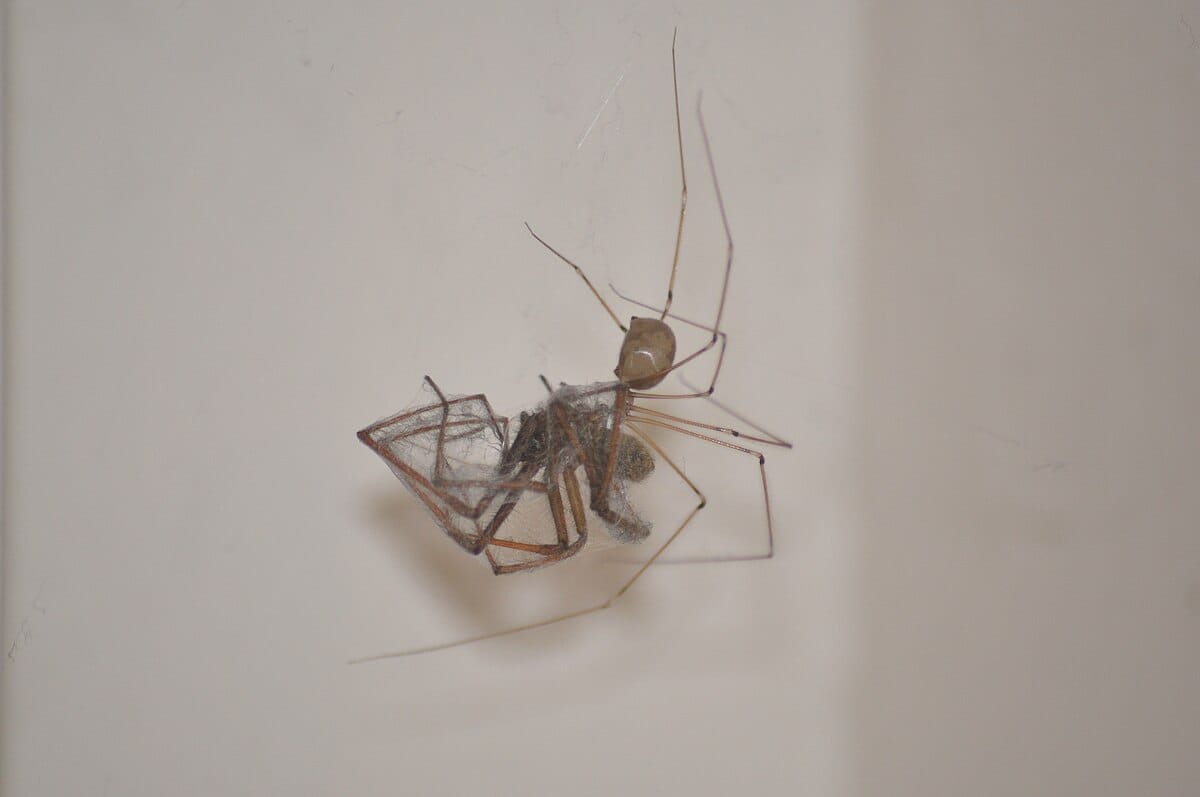
Often mistaken for harvestmen, the true Daddy Longlegs Spiders belong to the Pholcidae family. They’re the delicate, long-legged spiders you often see in corners of ceilings, garages, or basements, spinning irregular webs that look messy but work perfectly for catching small insects and mosquitoes.
Daddy Longlegs have extremely long, thin legs and small oval bodies. Their fragile appearance often leads people to underestimate them, but they are skilled hunters. They feed on insects, spiders, and other small invertebrates. Interestingly, they sometimes invade the webs of other spiders, using their long legs to pluck the strands and lure the resident spider closer—before striking with surprising speed.
A popular myth claims that Daddy Longlegs are the most venomous spiders in the world but can’t bite humans due to short fangs. In reality, their venom is mild and poses no threat. They rarely bite, and even if they did, the effects would be insignificant.
These spiders play an important role indoors by reducing pest numbers, including mosquitoes and gnats. Their gentle nature and peaceful coexistence with humans make them one of the friendliest household spiders. Next time you see one quietly hanging in a web corner, remember—it’s doing you a favor.
13. Mouse Spider (Missulena genus)
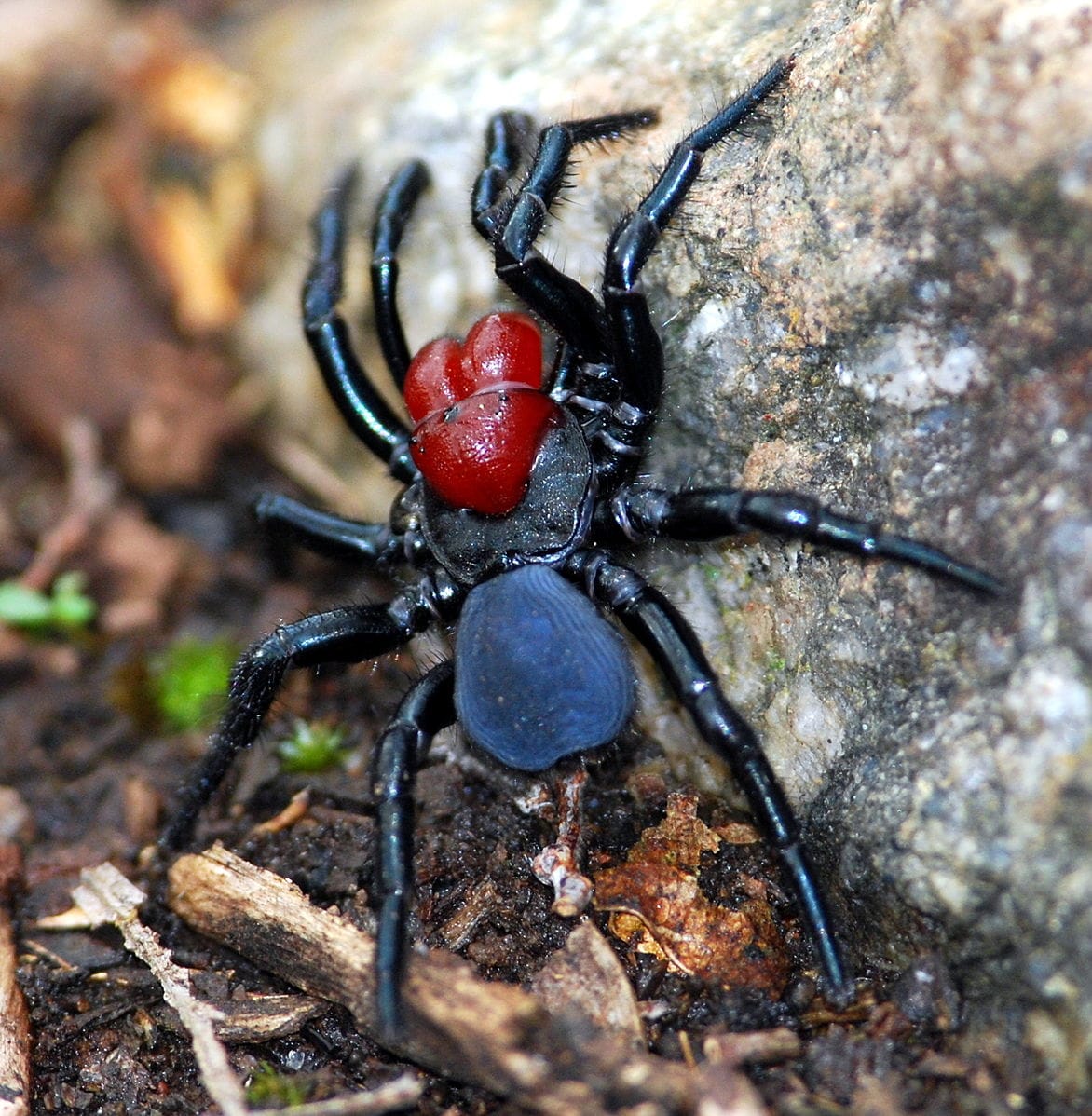
Named for their furry appearance, Mouse Spiders are stocky, ground-dwelling arachnids native to Australia and South America. Despite their cuddly name, they are far from soft—they possess strong fangs and potent venom, similar in composition to the infamous Funnel-Web Spider. Fortunately, they are shy by nature and rarely pose a threat to humans.
Mouse Spiders build burrows lined with silk and covered by trapdoors, much like their distant Trapdoor cousins. These burrows provide protection from predators and extreme weather. They are mostly active after rain, when males wander in search of females, sometimes accidentally venturing into human areas.
Their appearance is quite distinctive: large, shiny black bodies with powerful jaws and a glossy cephalothorax. Some species, such as the Red-Headed Mouse Spider (Missulena occatoria), feature a striking red head and jaws that contrast with their dark body.
Although their venom can be toxic, very few bites have been recorded, and no fatalities have occurred thanks to the availability of antivenom. Most Mouse Spiders are calm and non-aggressive unless provoked. Their fascinating behaviors and physical power make them one of the most intriguing spiders in Australia’s rich arachnid diversity.
14. Black House Spider (Badumna insignis)
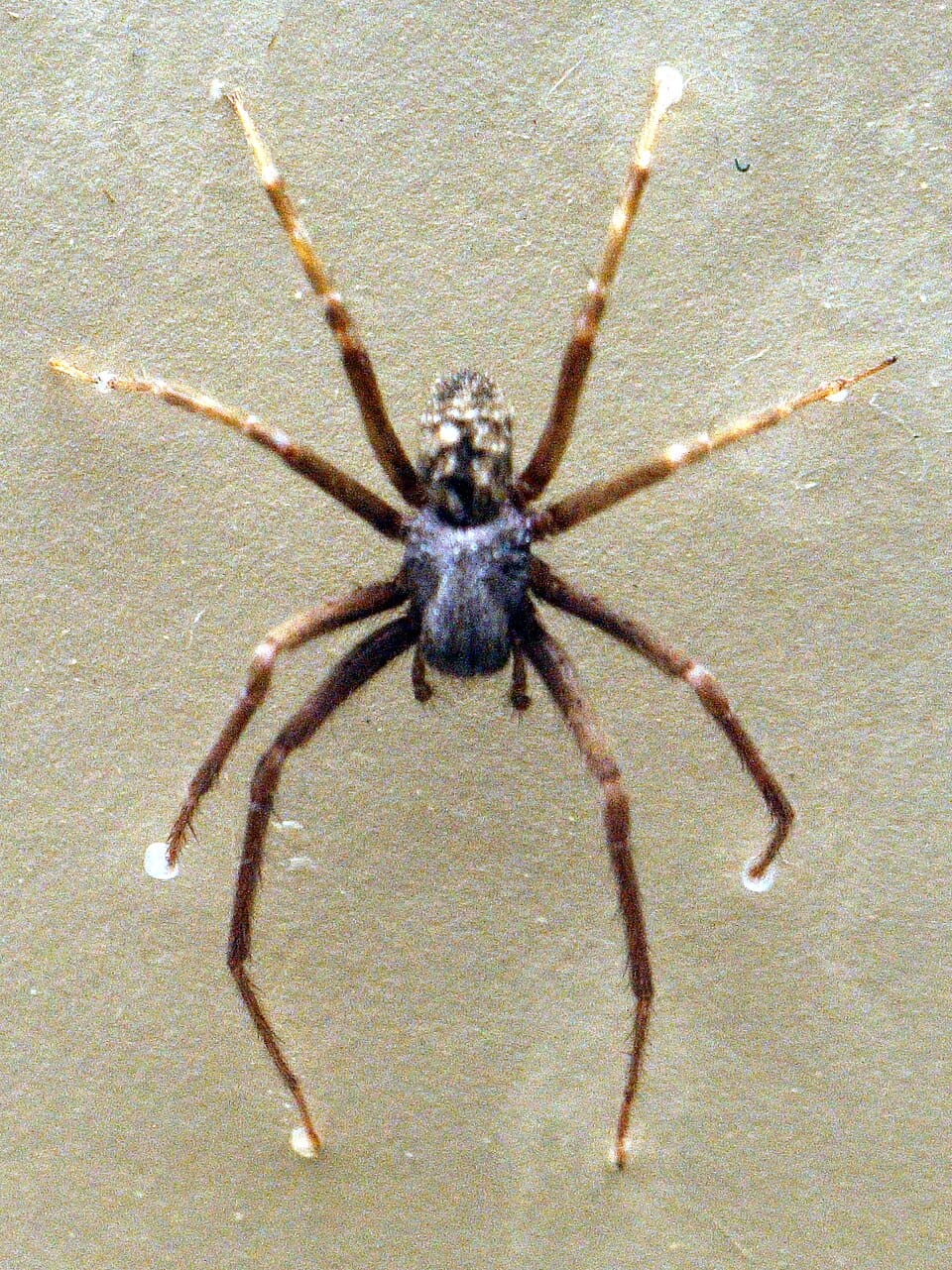
The Black House Spider is a common web-builder across Australia, often found in window corners, garden sheds, and under outdoor furniture. Though its dark color and messy web might seem menacing, it’s actually a shy and non-aggressive species that helps control household pests such as flies and mosquitoes.
This medium-sized spider has a velvety black or dark brown body, with females growing up to 1.5 cm long and males being smaller. Their webs are funnel-shaped and often dusty, giving them a “haunted” appearance. When prey enters, the spider darts out to bite and immobilize it before retreating back into the safety of its funnel.
While they can bite if cornered, Black House Spiders are not dangerous to humans. The bite may cause mild pain or swelling but no lasting effects. In fact, these spiders prefer to avoid confrontation and retreat whenever possible.
For homeowners, Black House Spiders are silent allies, helping keep insect populations in check. Once you recognize them as harmless pest controllers rather than invaders, they might even earn a bit of your respect.
15. Redback Spider (Latrodectus hasselti)
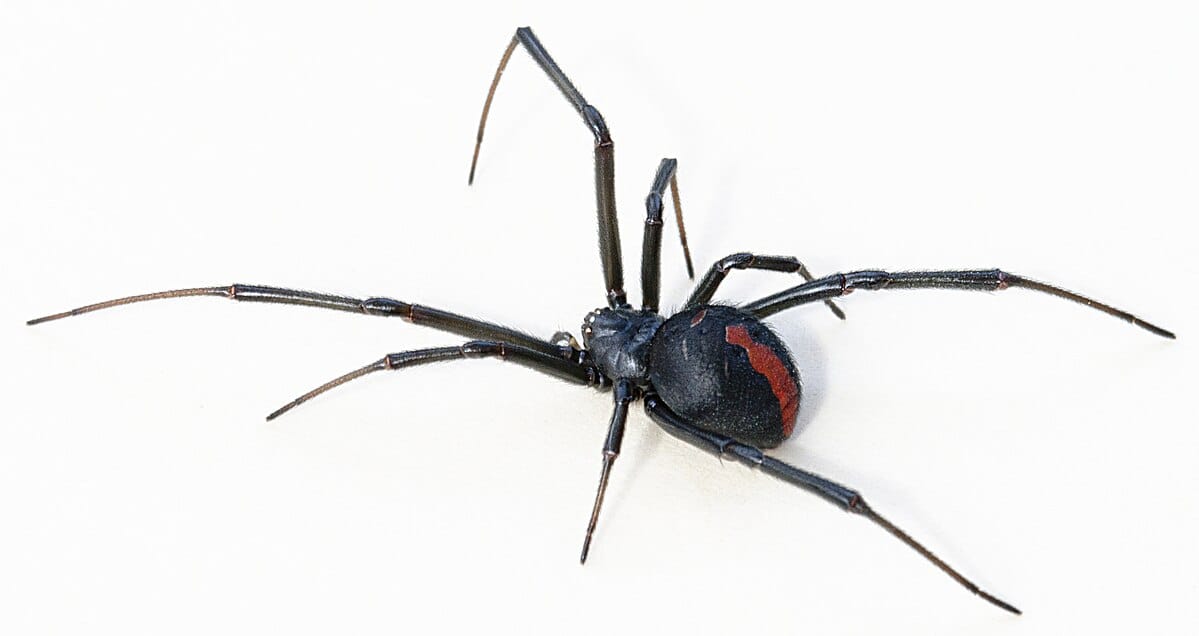
The Redback Spider is one of Australia’s most iconic and feared arachnids. Closely related to the Black Widow, it’s instantly recognizable by the bright red stripe running down the female’s glossy black abdomen. Found throughout Australia and parts of Southeast Asia, the Redback thrives in dry, sheltered areas such as sheds, garages, and outdoor furniture.
Females are much larger than males and are responsible for the species’ dangerous reputation. Their venom contains powerful neurotoxins that can cause severe pain, muscle weakness, and nausea. However, antivenom has been available since 1956, and no deaths have been recorded since its introduction.
Redbacks build messy, tangle-like webs close to the ground, where they trap crawling insects and sometimes small reptiles. The females remain in the web, rarely venturing out, while males spend their short lives searching for mates—often meeting a fatal end after mating.
Despite their fearsome reputation, Redback Spiders play an important role in nature’s balance by controlling insect populations. As long as they’re left undisturbed, they prefer to avoid humans entirely. Their striking colors and potent venom serve as a reminder of the beauty and danger coexisting in Australia’s wild landscapes.
16. Garden Spider (Argiope aurantia)

The Garden Spider, also known as the Yellow Garden Spider or Black-and-Yellow Argiope, is one of the most recognizable and admired spiders in the world. Found across North America, Asia, and parts of Europe, this orb-weaver is famous for its bright yellow markings and the large, circular webs it spins among garden plants and shrubs.
These spiders are harmless to humans and extremely beneficial for gardeners, as they feed on flies, mosquitoes, grasshoppers, and even small wasps. The female Garden Spider, much larger than the male, can reach up to 1 inch (2.5 cm) in body length and spins a web that can measure over 2 feet in diameter. The center of her web often features a unique zigzag silk pattern called a stabilimentum, which may reflect UV light to attract insects or strengthen the web’s structure.
Garden Spiders have an annual life cycle, typically living through one warm season. After mating, the female produces several egg sacs, each containing hundreds of spiderlings that hatch in the spring. The young disperse through a fascinating behavior called “ballooning,” where they release silk threads that carry them on the wind to new locations.
Despite their striking appearance, Garden Spiders are gentle and rarely bite unless directly threatened. They represent one of nature’s most beautiful examples of coexistence between humans and wildlife—keeping our gardens healthy and balanced in the most elegant way possible.
17. Spiny Orb-Weaver (Gasteracantha cancriformis)
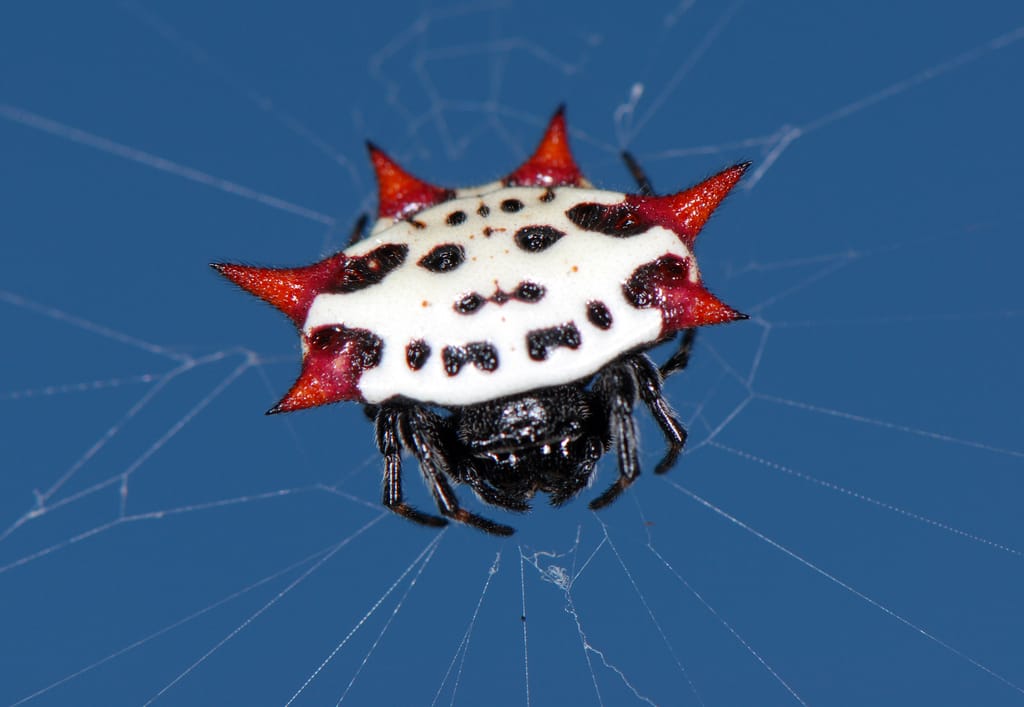
Often called the “crab spider” for its unique shape, the Spiny Orb-Weaver is one of the most visually distinctive spiders you’ll ever see. Its flattened, shell-like abdomen is brightly colored—white, yellow, red, or black—with six sharp spines protruding from the edges. These bold patterns serve as a warning to predators and make the spider appear larger and more dangerous than it is.
Spiny Orb-Weavers are small, rarely exceeding 0.5 inches (1.3 cm) in body length. They build neat, circular orb webs between trees, bushes, or garden plants. Females construct the web and sit proudly in the center, while males are much smaller and live nearby.
Despite their fierce appearance, these spiders are completely harmless to humans. They use mild venom to immobilize small flying insects and are more likely to flee than fight when disturbed. Their bright coloration and quirky shape make them a favorite among nature photographers.
Found in tropical and subtropical regions worldwide, the Spiny Orb-Weaver adds a touch of color and creativity to any landscape—proof that even the smallest creatures can have the most extraordinary designs.
18. Sydney Funnel-Web Spider (Atrax robustus)
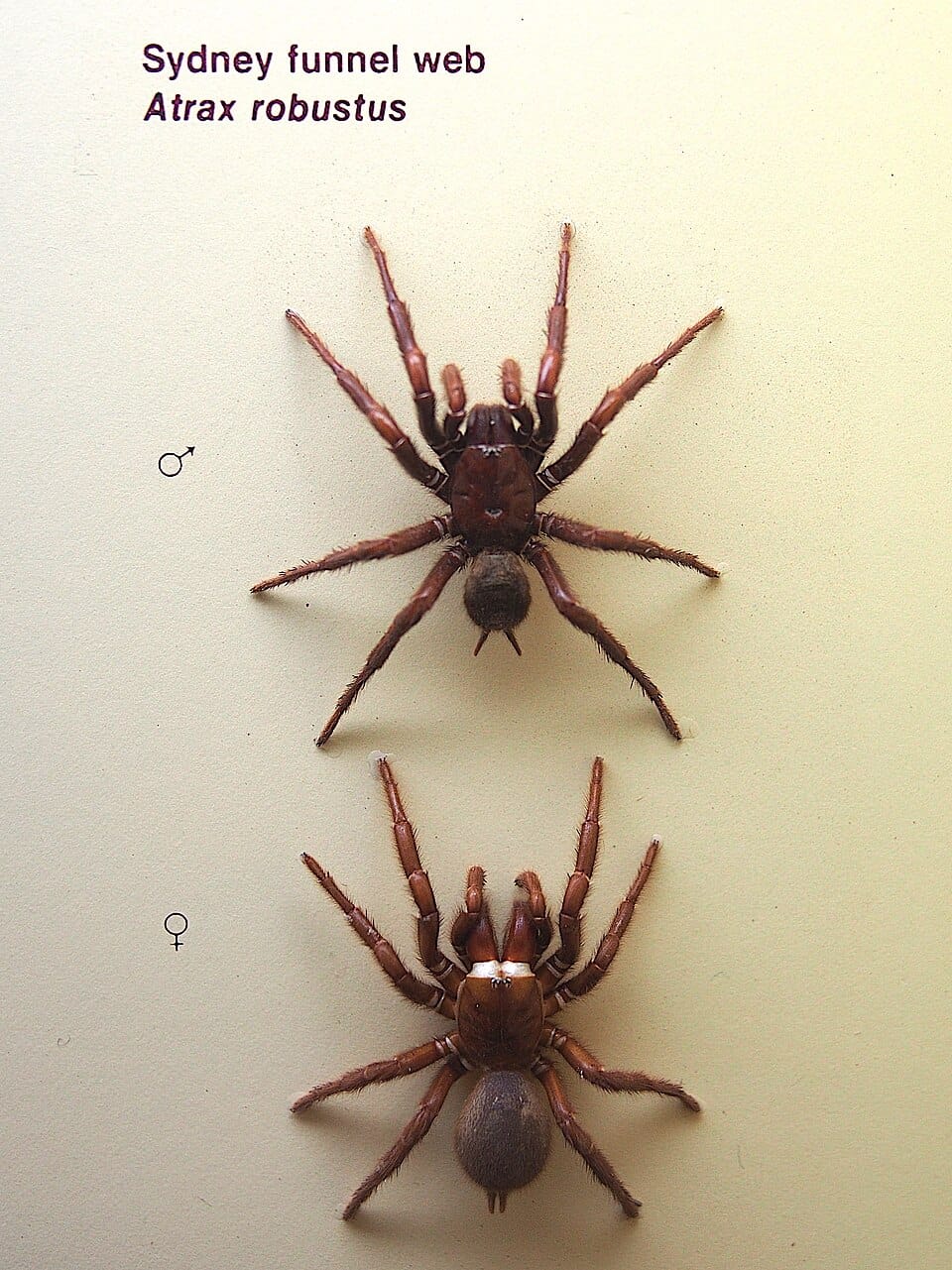
The Sydney Funnel-Web Spider is one of the most infamous arachnids in the world, known for its potent venom and aggressive defensive behavior. Native to eastern Australia, particularly around Sydney, this species prefers moist, sheltered habitats such as gardens, under logs, or in rock crevices. It builds silk-lined burrows with funnel-shaped entrances—hence the name “Funnel-Web.”
These spiders are medium to large in size, with glossy black or dark brown bodies and powerful fangs capable of piercing fingernails. Males are more venomous than females and are often the ones encountered wandering in search of mates, especially during summer months.
Despite their reputation, fatalities are now extremely rare thanks to the availability of antivenom and increased awareness. The Sydney Funnel-Web Spider plays an essential role in controlling insect and small vertebrate populations, proving that even feared species have their ecological importance.
Its combination of strength, intelligence, and resilience makes it one of nature’s most impressive predators—and a reminder to respect, rather than fear, the wild.
19. Crab Spider (Thomisidae family)
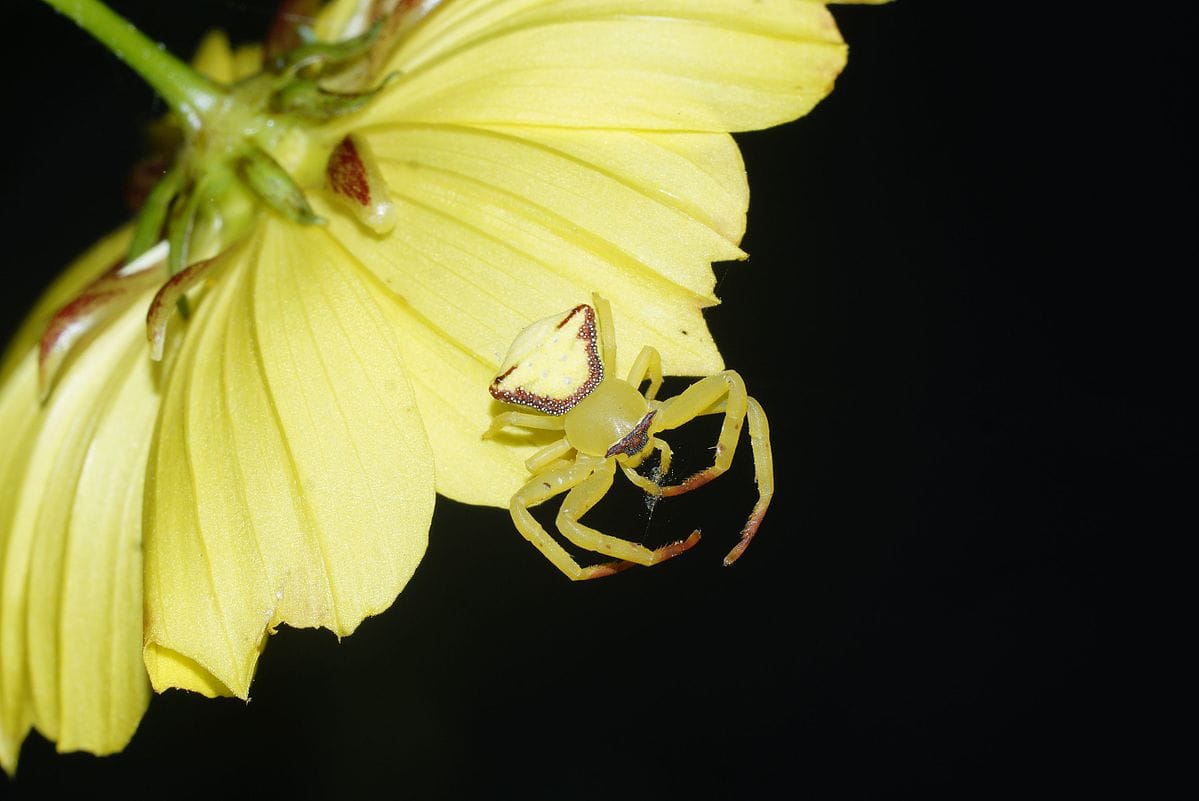
Named for their crab-like shape and sideways movement, Crab Spiders are a diverse group found all over the world. They don’t spin webs to catch prey—instead, they use camouflage and patience. Most species sit motionless on flowers or leaves, waiting for pollinators to come within reach, then strike with lightning speed.
Crab Spiders vary in color from white and yellow to bright pink, allowing them to blend perfectly with their surroundings. Some can even change color over several days to match the flower they’re sitting on, making them masters of disguise.
Unlike web-weavers, Crab Spiders rely on raw ambush tactics. They have powerful front legs for grabbing prey and a calm, calculated approach to hunting. Their diet includes bees, flies, and other insects much larger than themselves.
Completely harmless to humans, Crab Spiders are fascinating examples of nature’s stealth and adaptability. They prove that sometimes, the best hunting strategy is simply to wait.
20. Camel Spider (Solifugae order)
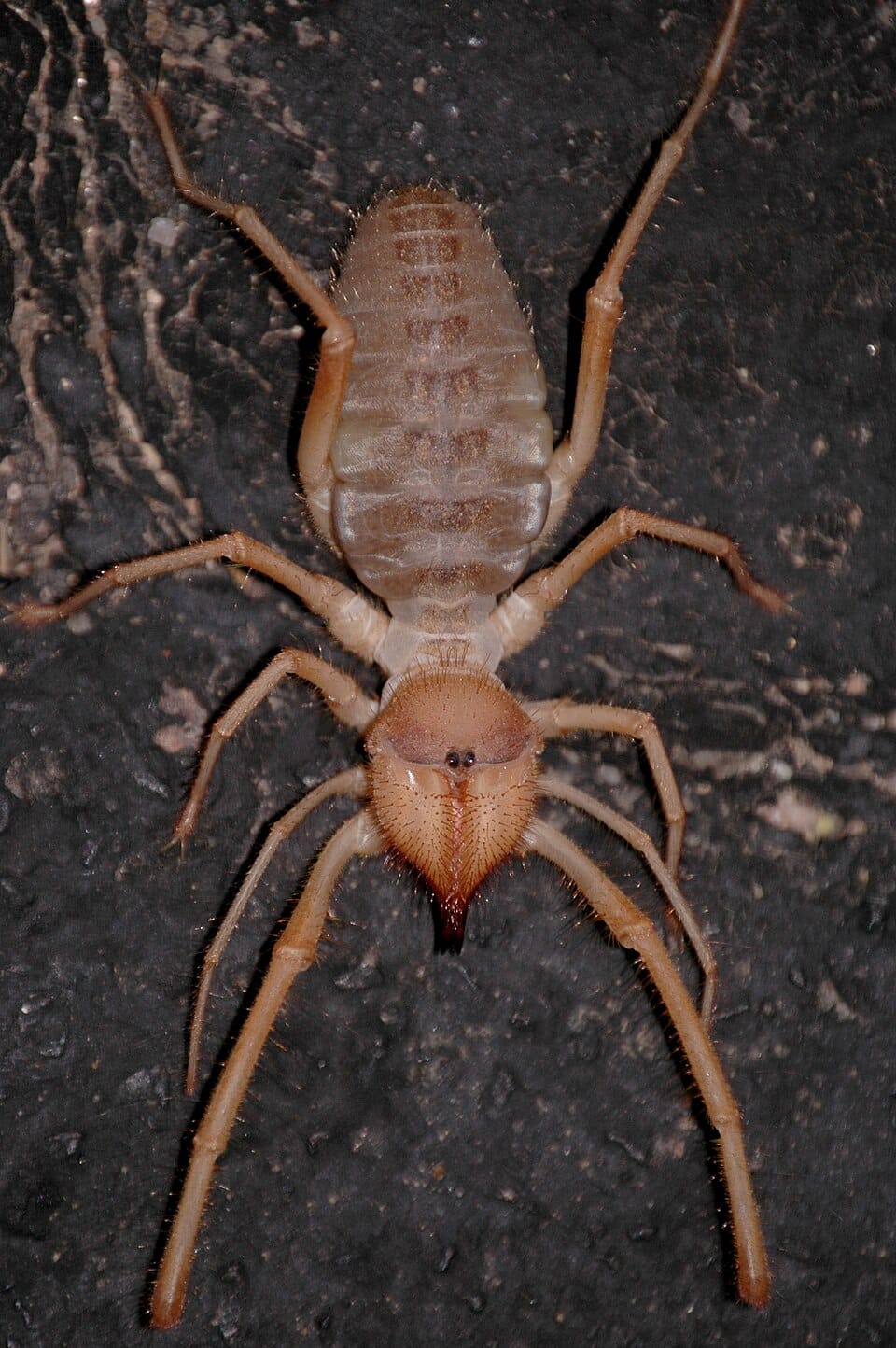
Although often mistaken for true spiders, Camel Spiders belong to a separate order known as Solifugae. Found mainly in deserts and arid regions of Africa, the Middle East, and North America, these fearsome-looking creatures are famous for their speed, strength, and exaggerated myths.
They can reach lengths of up to 6 inches (15 cm) including legs and are covered in fine hairs that help them sense vibrations and navigate hot sand. Camel Spiders are nocturnal hunters that rely on speed rather than venom to subdue prey. They use their large, scissor-like jaws to crush insects, small reptiles, and even rodents.
Despite terrifying rumors spread during wartime, Camel Spiders are non-venomous and pose no real danger to humans. Their intimidating appearance hides a fascinating truth—they are efficient desert survivors, evolved to thrive in one of the harshest environments on Earth.
Observing a Camel Spider in motion is like watching nature’s perfect desert predator at work—swift, silent, and superbly adapted.
21. Fishing Spider (Dolomedes genus)
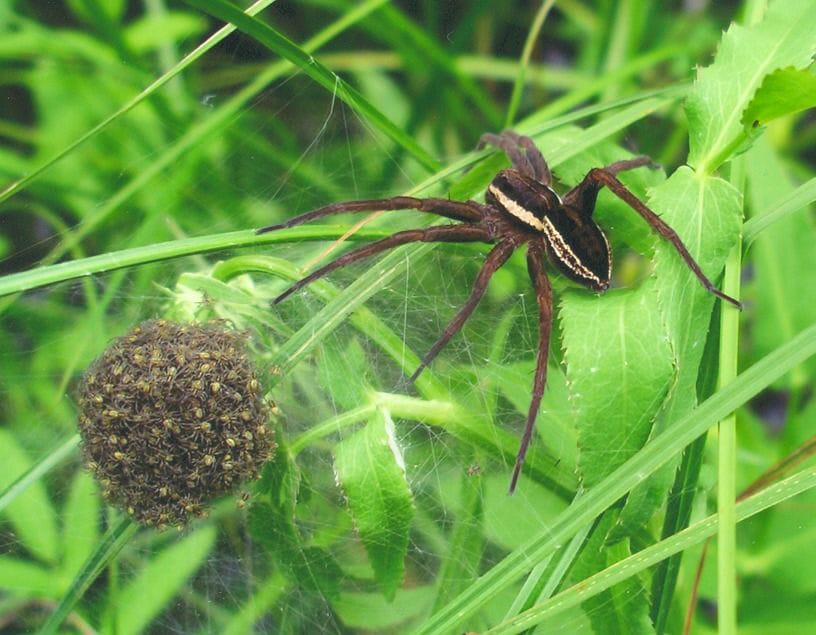
The Fishing Spider, sometimes called the “Raft Spider,” is a semi-aquatic hunter found near lakes, ponds, and streams across North America and Europe. Unlike most spiders, it can walk on water and even dive beneath the surface to catch prey. Using the fine hairs on its legs, it detects vibrations caused by struggling insects or small fish on the water’s surface.
Fishing Spiders are large, with leg spans up to 3 inches (7.5 cm), and feature brown or gray coloring with subtle patterns for camouflage among reeds and rocks. Females are significantly larger than males and are known to carry their egg sacs in their jaws until hatching.
When hunting, the spider anchors itself to vegetation and waits patiently, then skims across the water to grab prey. It can stay submerged for up to 30 minutes, breathing through trapped air bubbles on its body.
Though they may look intimidating, Fishing Spiders are gentle giants of the wetland world—remarkable examples of how spiders can adapt to virtually any habitat on Earth.
22. Giant Huntsman Spider (Heteropoda maxima)
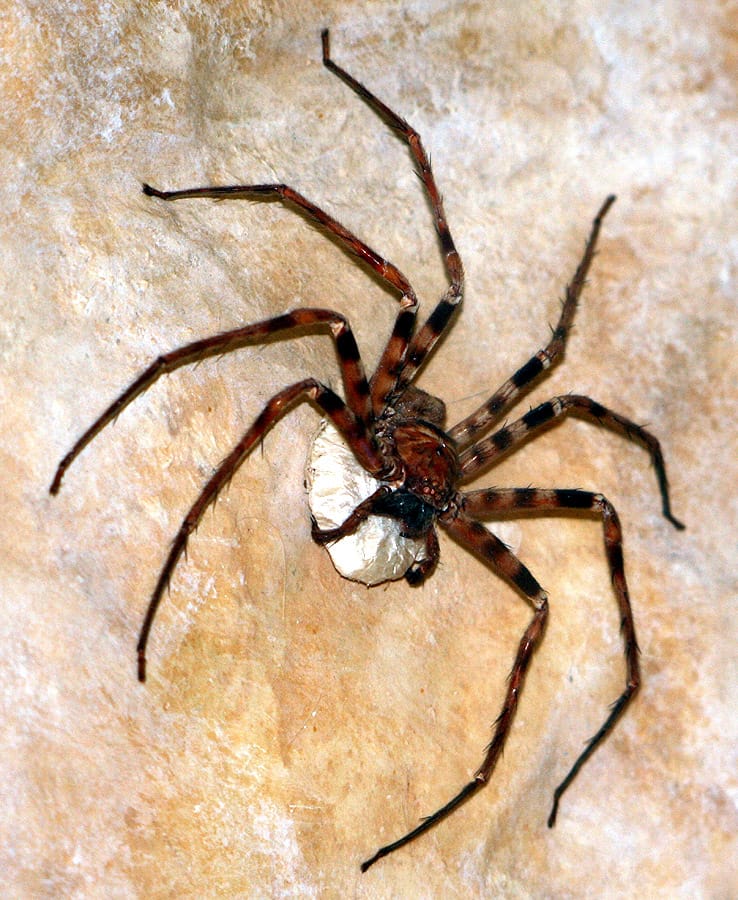
The Giant Huntsman Spider holds the record for the largest leg span of any spider on Earth—up to 12 inches (30 cm) across. Discovered in Laos, this species belongs to the Huntsman family, known for their speed and agility rather than web-building. With long, crab-like legs splayed out sideways, it can move quickly across rocks, walls, and forest floors.
Despite its size and fearsome appearance, the Giant Huntsman is not dangerous to humans. Its venom is mild, and it prefers to flee rather than fight. These spiders are nocturnal hunters that rely on stealth to capture insects, lizards, and other small prey.
They are pale brown or tan in color, blending into cave walls and tree bark. Their flat bodies allow them to slip into tight spaces, an adaptation that helps them survive in the limestone caves of Southeast Asia.
The Giant Huntsman Spider is a breathtaking example of nature’s extremes—proof that even the biggest predators can be graceful, intelligent, and misunderstood.
23. Woodlouse Spider (Dysdera crocata)
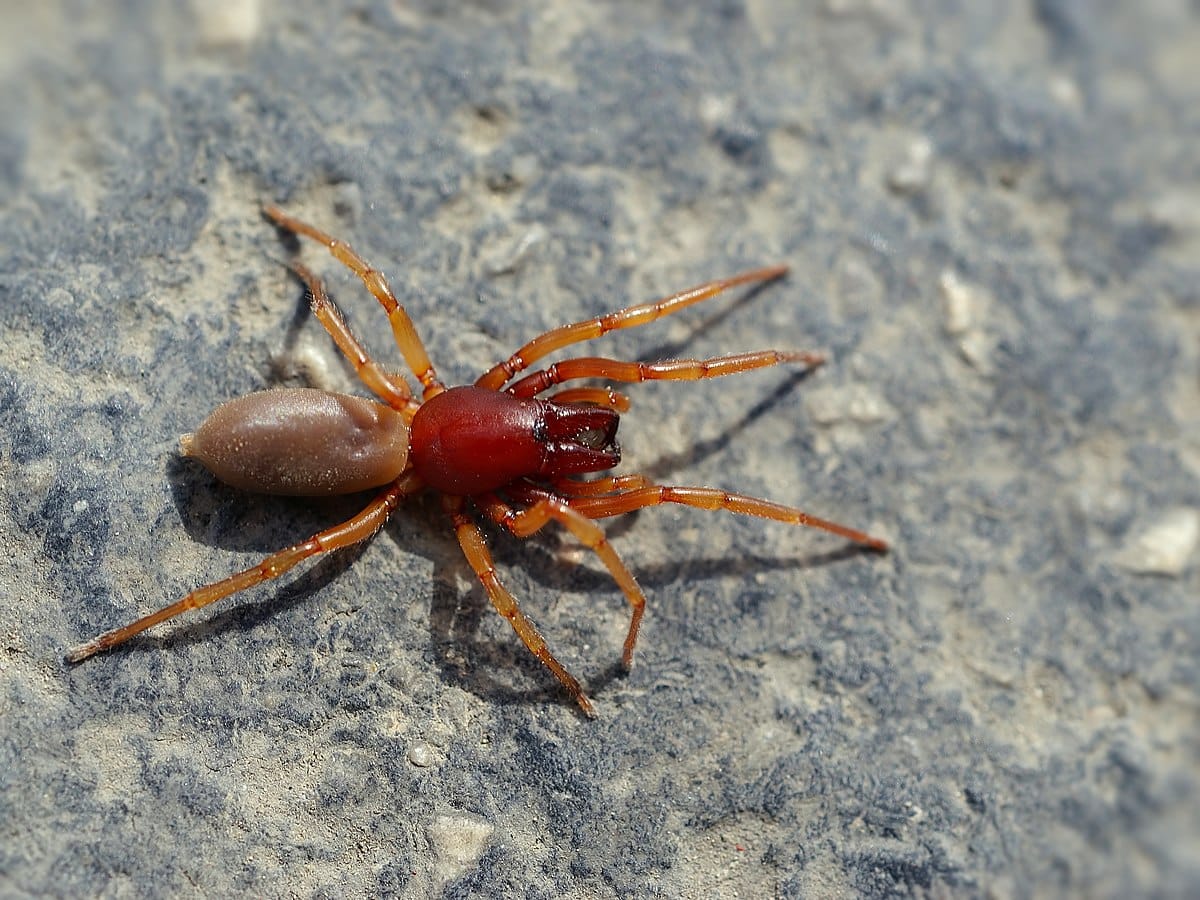
The Woodlouse Spider is instantly recognizable by its reddish-orange body and powerful fangs, which it uses to prey on woodlice (pill bugs). Found worldwide, especially in dark and damp areas such as basements, under stones, or logs, this spider is an expert hunter rather than a web builder.
Adults measure about 11–15 mm in length, with a reddish cephalothorax and legs, and a grayish-beige abdomen. Their fangs are longer than those of most spiders their size, perfectly adapted to pierce the hard shells of woodlice. Unlike many species, they hunt at night and rely on stealth and speed instead of webs.
While their bite can look intimidating, it is not dangerous to humans—causing only minor local pain or swelling. The Woodlouse Spider plays a key ecological role by controlling woodlouse populations, keeping soil ecosystems balanced. It’s a reminder that even small predators have big responsibilities in nature.
24. Garden Orb-Weaver (Araneus diadematus)
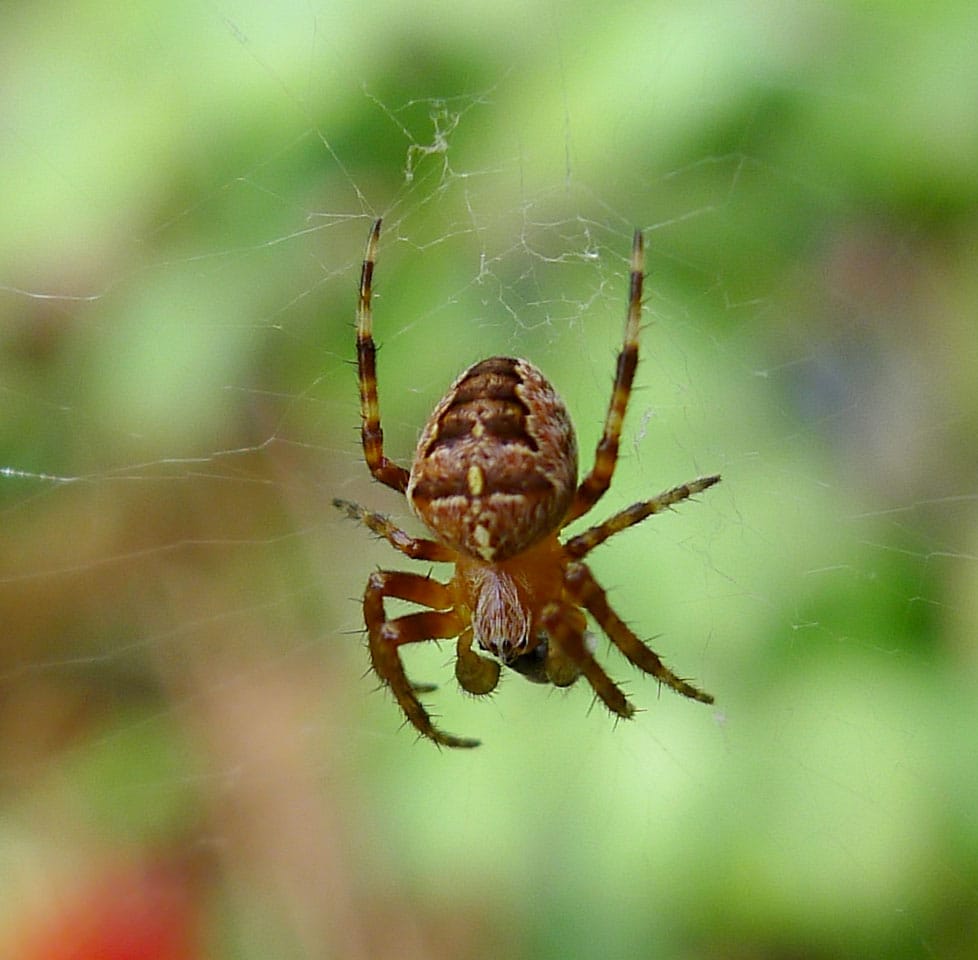
The Garden Orb-Weaver, also called the Cross Spider, is one of the most familiar spiders in gardens across Europe and North America. These spiders are masters of web-building, spinning perfectly symmetrical orb-shaped webs that glisten beautifully in the morning dew. They usually rebuild their webs every evening to ensure maximum stickiness for trapping flying insects.
Recognized by the white cross-shaped pattern on their abdomen, Garden Orb-Weavers vary in color from yellow to dark brown. Females are larger, reaching up to 18 mm, while males are smaller and more reclusive.
They are harmless to humans and are actually beneficial, feeding on mosquitoes, flies, and moths. Watching one at work is like witnessing a tiny engineer in action—measuring, weaving, and repairing with precision. The Garden Orb-Weaver embodies the quiet artistry of nature, transforming something as simple as silk into a masterpiece of survival.
25. False Widow Spider (Steatoda nobilis)
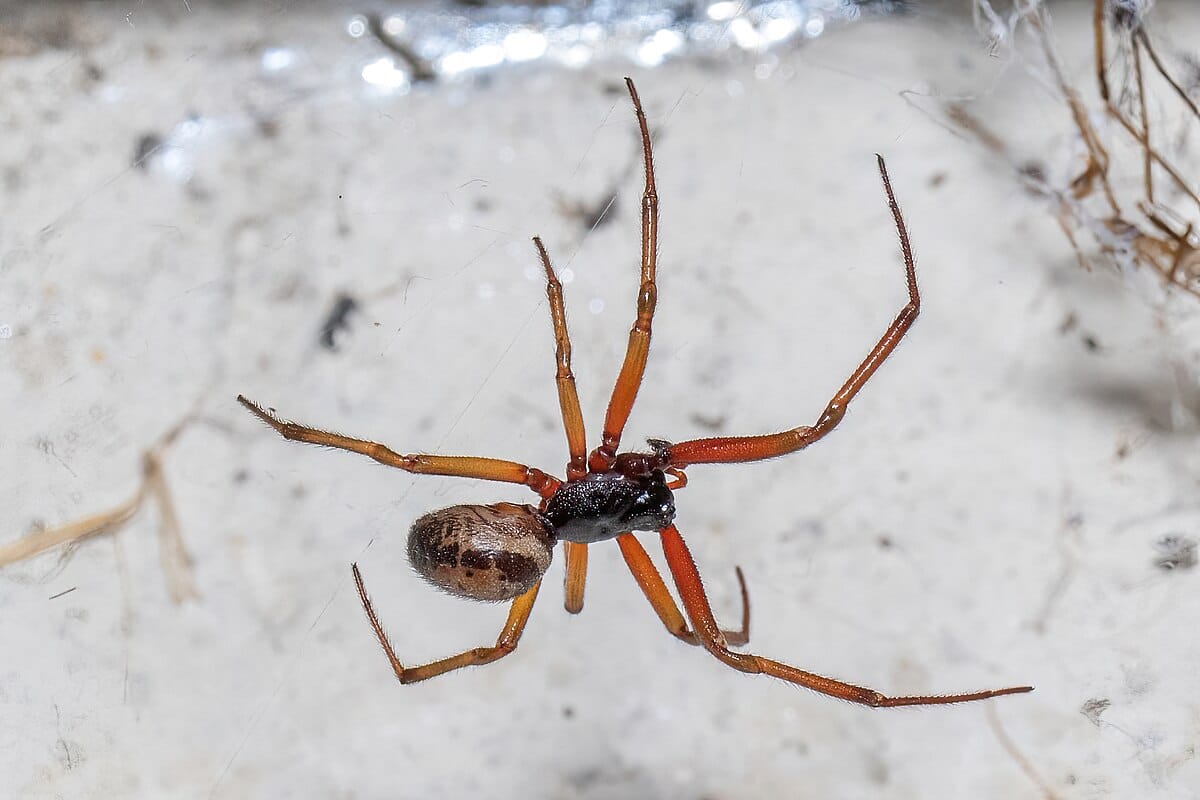
Often confused with the infamous Black Widow, the False Widow Spider is less dangerous but still commands attention. Originating from the Canary Islands, it has spread to Europe, North America, and other temperate regions. Females are shiny, dark brown to black, with a bulbous abdomen featuring pale markings that can resemble a skull or hourglass.
False Widows prefer warm, sheltered environments such as attics, sheds, and garden furniture. They build irregular cobwebs to catch crawling insects. While their venom can cause mild pain, it is far from life-threatening, and most bites occur only when the spider is accidentally pressed against the skin.
This species has adapted well to human environments, showing remarkable resilience and intelligence. Despite their reputation, False Widows are fascinating creatures—capable of surviving diverse climates and maintaining delicate ecological balance by preying on pest insects.
26. Silver Argiope (Argiope argentata)
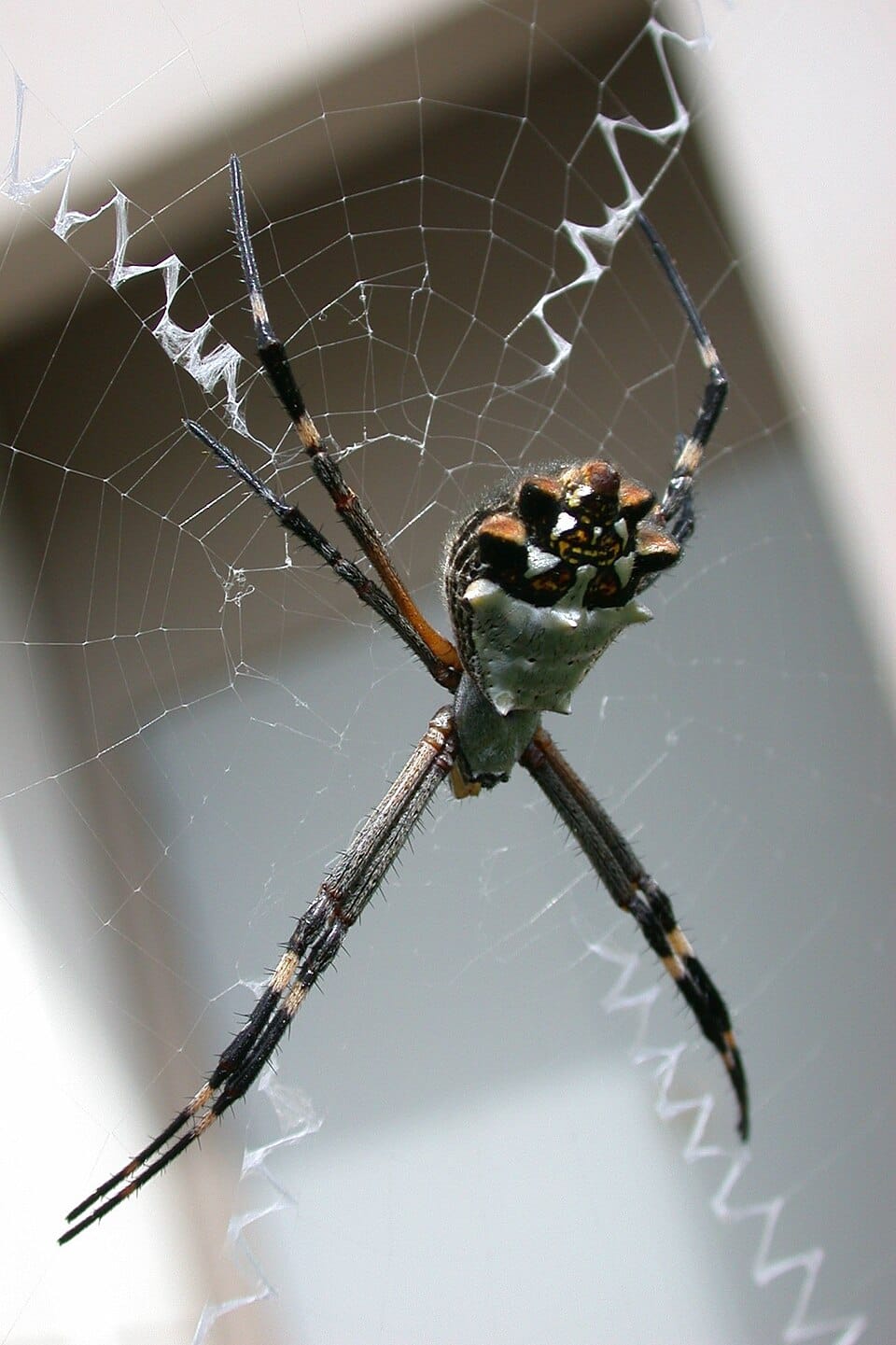
The Silver Argiope is a strikingly beautiful spider found throughout the Americas, especially in warmer climates. Its body gleams with silvery-white scales that reflect sunlight, providing camouflage against predators. Females are much larger than males and weave intricate orb webs with distinctive zigzag patterns (called stabilimenta) at the center.
These stabilimenta are believed to strengthen the web or attract prey by reflecting ultraviolet light. The Silver Argiope is a patient hunter, sitting motionless at the center of its web with legs arranged in an “X” shape—an iconic stance of the Argiope genus.
Harmless to humans and visually stunning, this spider helps control insect populations while adding a flash of metallic brilliance to gardens and fields. Observing a Silver Argiope in sunlight feels like finding a jewel woven into silk—a perfect harmony of beauty and function.
27. Bold Jumping Spider (Phidippus audax)
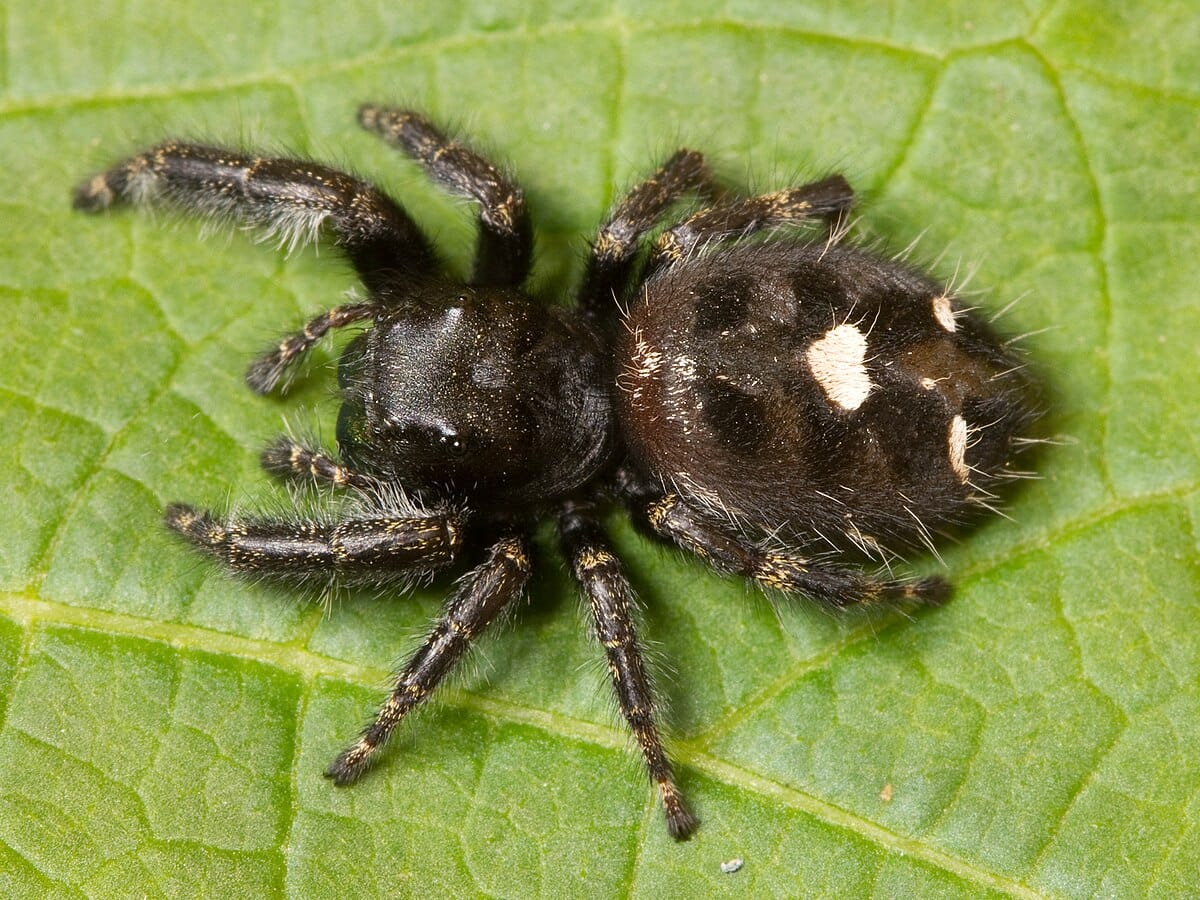
Ending our list is one of the most charismatic spiders on Earth—the Bold Jumping Spider. Found across North America, it’s famous for its large forward-facing eyes, curious behavior, and dazzling metallic green fangs. Despite its small size (about 1.5 cm), it is an agile predator with vision rivaling that of much larger animals.
Rather than spinning webs to trap prey, the Bold Jumping Spider actively hunts during the day, leaping several times its body length to ambush insects. It uses a silk tether as a safety line in case it misses the jump—an ingenious evolutionary adaptation. These spiders often observe humans with apparent curiosity, turning their heads to follow movement, giving them an almost “pet-like” personality.
Completely harmless to people, they are beloved by photographers and researchers alike for their intelligence and expressive appearance. The Bold Jumping Spider reminds us that even the tiniest creatures can be both fierce and endearing—a perfect ending to our journey through the world of spiders.
28. Banana Spider (Phoneutria fera)
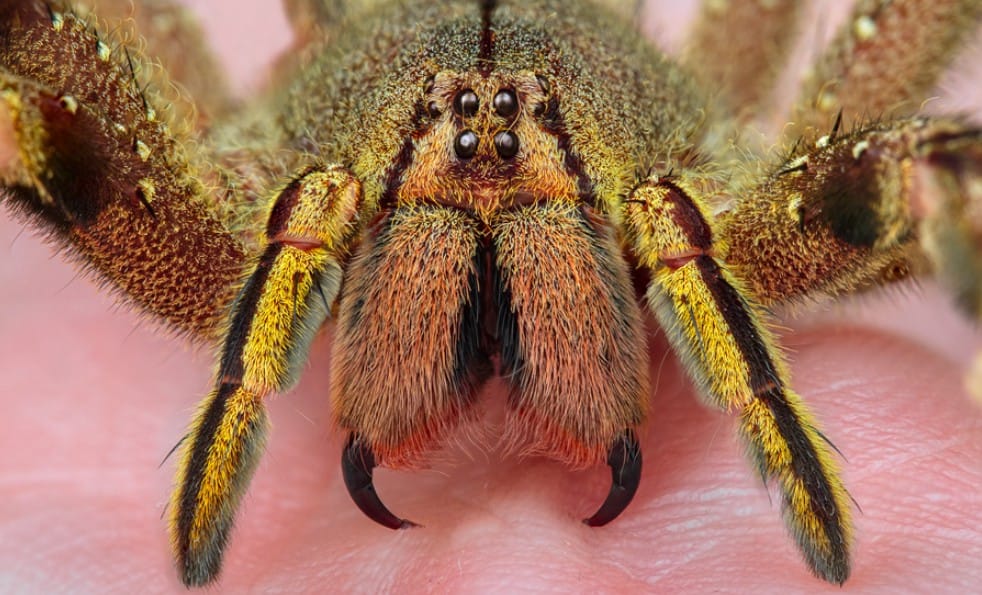
The Banana Spider, also known as the Brazilian Wandering Spider, is one of the most infamous types of spiders due to its potent venom and fearless behavior. Native to the rainforests of South America, this species is often found in banana plantations — which is how it got its common name. Despite its alarming reputation, actual encounters with humans are rare, and fatal bites are even rarer thanks to improved medical treatments.
Appearance and Identification
Banana Spiders are large and intimidating, with long, sturdy legs spanning up to 5 inches. Their bodies are brown or grayish with darker stripes or patterns, giving them excellent camouflage among leaves and tree bark. They are nocturnal hunters, often seen wandering the forest floor rather than building webs.
Behavior and Habitat
Unlike web-building spiders, the Banana Spider actively hunts its prey. It feeds on insects, small lizards, and occasionally frogs, using its fast reflexes and potent venom to subdue them. During the day, it hides in dark, humid spaces such as under logs, in shoes, or among fruit bunches — which led to its “banana” legend.
Venom and Human Interaction
The venom of Phoneutria fera is neurotoxic, capable of causing intense pain, sweating, and muscle cramps. However, antivenoms and prompt medical care have made bites extremely survivable today. While it’s considered one of the world’s deadliest spiders, it’s not aggressive unless threatened.
Fun Fact
Interestingly, research on Banana Spider venom has led to potential medical breakthroughs, including compounds that may help treat erectile dysfunction — a surprising benefit from one of nature’s most feared creatures.
29. Chilean Recluse Spider (Loxosceles laeta)
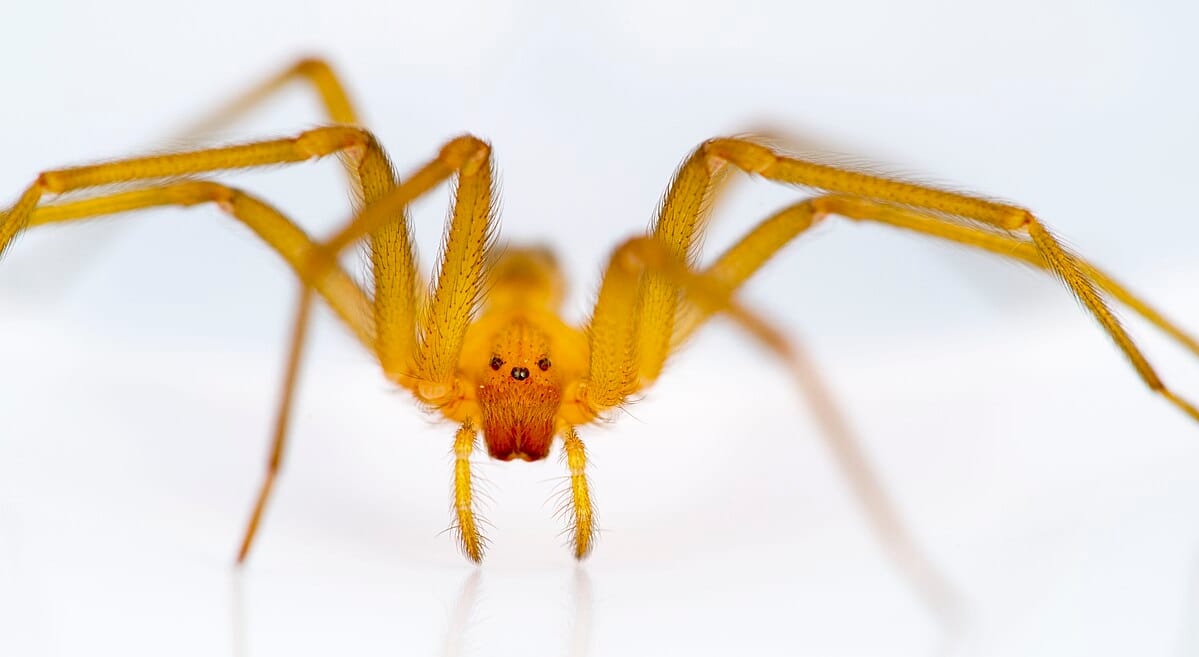
The Chilean Recluse Spider is another species known for its medically significant bite. Found throughout South America — especially in Chile, Peru, and Argentina — this spider prefers quiet, dark spaces like closets, attics, and behind furniture. It’s closely related to the Brown Recluse found in North America but tends to be slightly larger and more venomous.
Identification and Features
Chilean Recluses are small to medium-sized spiders, about 1 cm long, with long, slender legs. Their most recognizable feature is the dark, violin-shaped mark on their cephalothorax. This marking earned them the nickname “fiddleback spider.”
Behavior and Lifestyle
True to its name, this spider is reclusive and avoids human contact. It builds irregular webs used mainly as a retreat rather than a trap. At night, it hunts small insects, often scavenging rather than chasing live prey.
Venom and Risks
Its venom contains necrotic agents that can cause skin damage and, in rare cases, systemic illness. However, most bites heal without complications if treated promptly. Despite its fearsome reputation, this spider plays an important ecological role by controlling pest populations.
Did You Know?
The Chilean Recluse is one of the few spiders capable of surviving months without food or water — an adaptation that helps it thrive in dry indoor environments.
30. Desert Tarantula (Aphonopelma chalcodes)
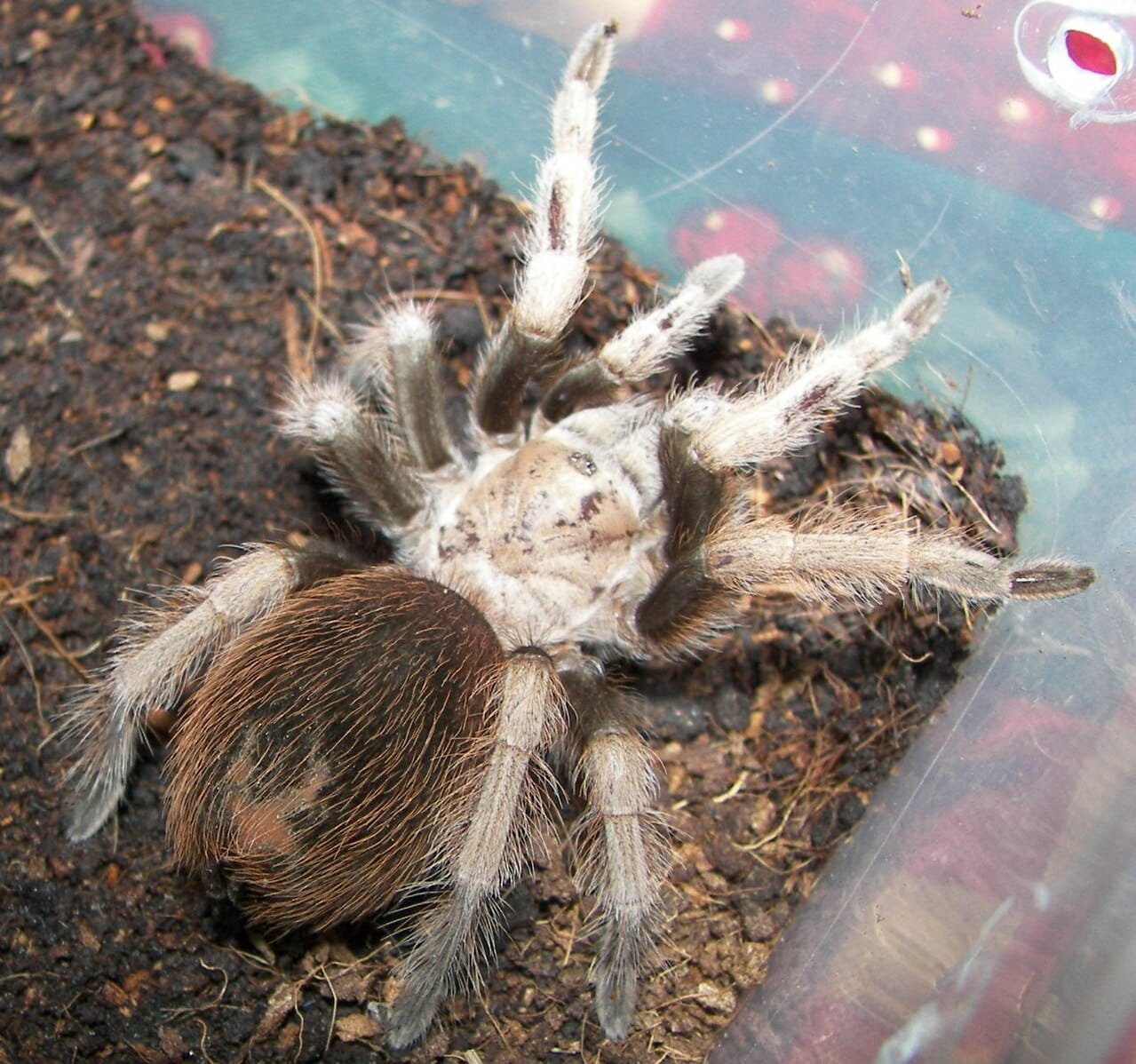
If you’ve ever walked through the deserts of Arizona or New Mexico, you might have seen the Desert Tarantula — a calm, ground-dwelling spider that looks more intimidating than it really is. Also known as the Arizona Blond Tarantula, it’s one of the most iconic types of spiders in the American Southwest.
Physical Description
Females are large and stocky, with bodies up to 2 inches long and legs reaching 5 inches. Their color varies from tan to dark brown, with females displaying a lighter, almost golden hue. Males are typically darker and wander more often during the mating season.
Habitat and Behavior
Desert Tarantulas live in burrows dug into sandy soil or abandoned by other animals. They line the entrance with silk to detect vibrations from passing prey. As nocturnal hunters, they feed on insects, small frogs, and even baby mice. They rely on ambush tactics rather than webs.
Personality and Defense
Despite their size, these tarantulas are docile. When threatened, they may raise their front legs or flick urticating hairs from their abdomen, which can irritate skin and eyes. However, bites are rare and mild, similar to a bee sting.
Fun Fact
Females can live for more than 25 years, while males typically live only 5–10 years — a striking example of how nature balances survival between the sexes.
31. Pink Toe Tarantula (Avicularia avicularia)
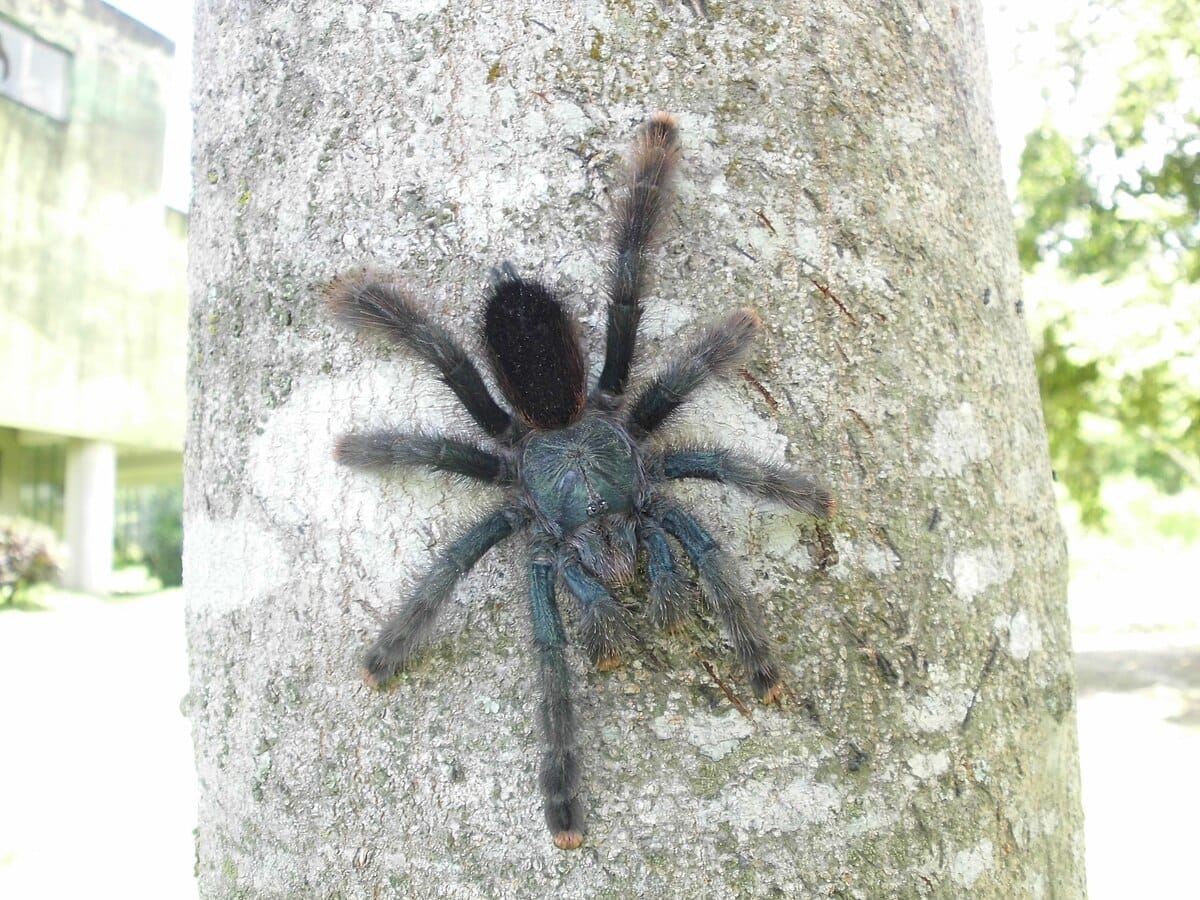
The Pink Toe Tarantula is one of the most beautiful and gentle types of spiders, admired by pet enthusiasts around the world. Originating from the rainforests of South America, particularly Guyana and Brazil, it is known for its docile nature and soft pink-tipped feet.
Appearance
This medium-sized tarantula has a velvety black or dark blue body, covered in fine hairs. The ends of its legs feature pale pink pads, giving it an elegant and friendly look. Males are generally slimmer, while females are rounder and live longer.
Behavior
Unlike most tarantulas that live on the ground, the Pink Toe Tarantula is arboreal, meaning it spends its life in trees. It constructs silk tunnels among branches, where it hides during the day and comes out to hunt at night.
Care and Temperament
In captivity, they’re known for their calm demeanor and ease of care. However, they can jump surprisingly far when startled — a rare trait among tarantulas. Their venom is mild and poses no threat to humans.
Interesting Fact
Pink Toe Tarantulas play a unique role in their ecosystem by preying on flying insects like moths and small beetles, helping control populations that might otherwise damage rainforest vegetation.
32. Green Bottle Blue Tarantula (Chromatopelma cyaneopubescens)
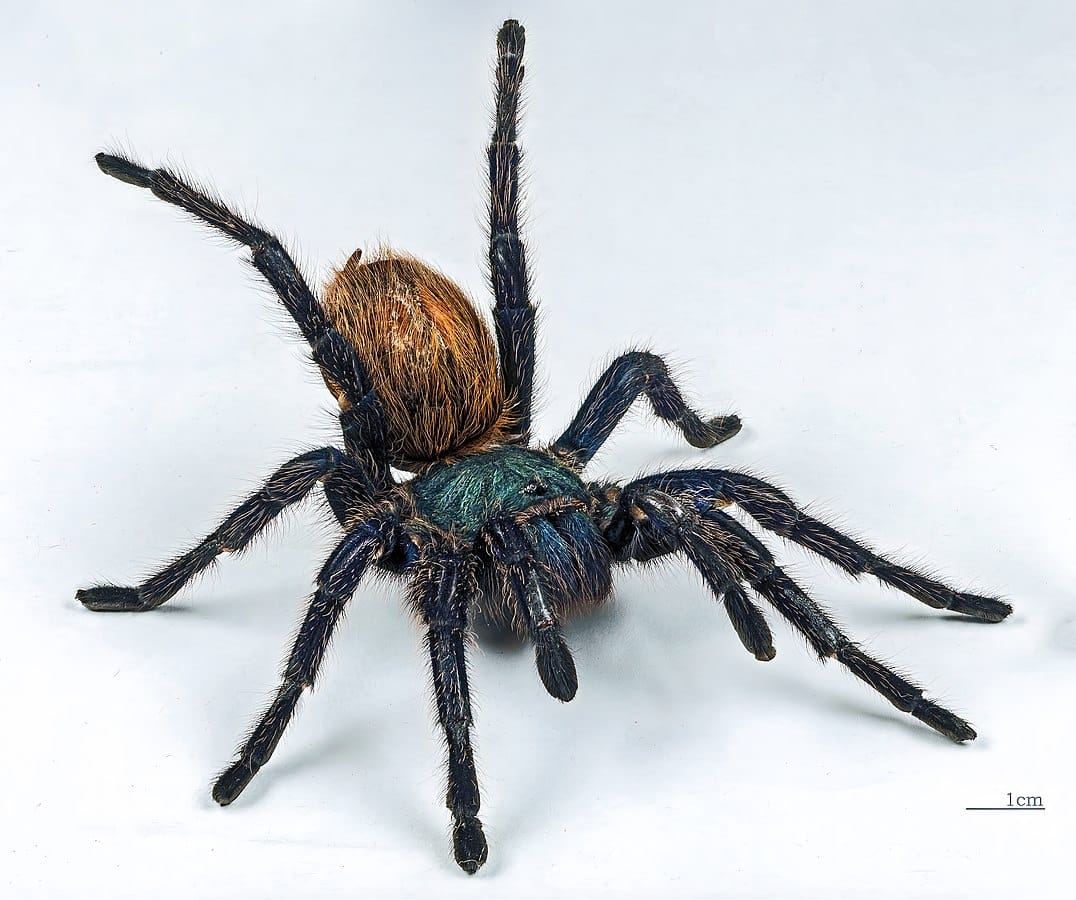
If there were a “supermodel” among types of spiders, the Green Bottle Blue Tarantula would easily win. Native to the dry scrublands of northern Venezuela, this species is adored for its vivid colors — a metallic blue body, emerald-green carapace, and bright orange abdomen covered in fine hairs.
Appearance and Identification
Juveniles start dull in color but transform into radiant adults after several molts. Females are larger and more vividly colored than males, often reaching a 6-inch leg span.
Habitat and Lifestyle
Unlike most tarantulas, the Green Bottle Blue prefers arid environments over humid ones. It creates silken tunnels at the base of shrubs or rocks, using its webbing extensively both for protection and prey detection. Despite being a burrower, it’s quite active and visible compared to other tarantulas.
Temperament
This species is fast but generally not aggressive. When disturbed, it prefers to retreat rather than bite. Its venom is mild, making it a favorite among tarantula keepers.
Ecological Importance
By preying on crickets, grasshoppers, and beetles, it maintains the natural balance in Venezuela’s desert ecosystems. Its bright colors also serve as a warning to predators, signaling that it’s not an easy meal.
33. Skeleton Tarantula (Ephebopus murinus)
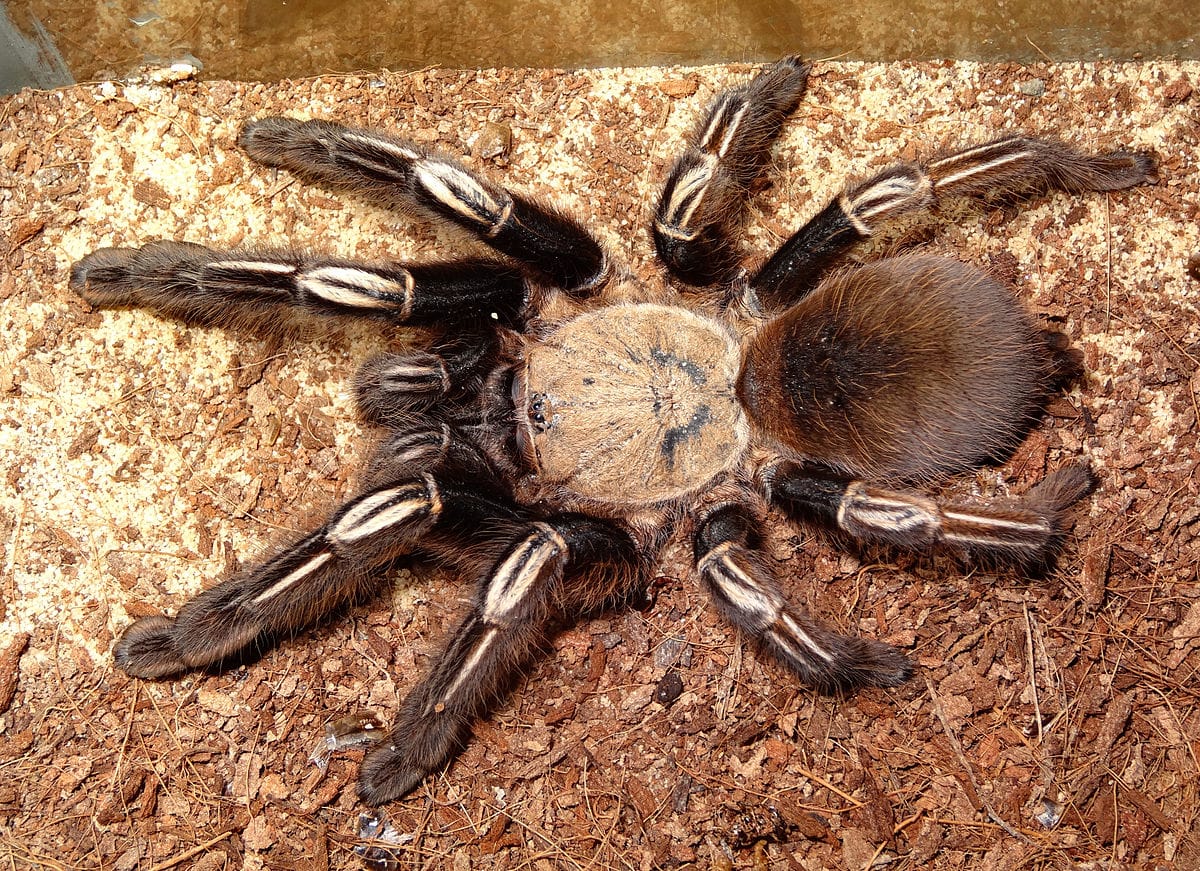
Among the most striking types of spiders in the tarantula world, the Skeleton Tarantula gets its eerie name from the distinct white or cream-colored markings on its legs that resemble human bones. Native to the rainforests of northern Brazil, Suriname, and French Guiana, this species blends cryptic camouflage with dramatic coloration — a mix that makes it both beautiful and mysterious.
Appearance
Adult females can reach up to 6 inches in leg span, displaying a velvety brown body with pale stripes running down the legs. When light hits them just right, the patterns look skeletal — hence their chilling nickname. Unlike most tarantulas, Ephebopus murinus also sports a golden sheen on its cephalothorax, which adds to its exotic look.
Behavior and Habitat
This tarantula is semi-burrowing, preferring humid environments like leaf litter or fallen logs. It constructs silken tunnels leading to a burrow, which it fiercely guards. Unlike more docile tarantulas, Skeleton Tarantulas can be defensive and fast-moving when threatened.
Venom and Defense
Their venom isn’t deadly to humans but can cause localized pain and swelling. Instead of biting, they often use a unique defense mechanism — they have urticating hairs on their pedipalps (near their fangs), unlike most tarantulas that have them on the abdomen. These hairs cause itching or irritation when flicked.
Interesting Fact
The Skeleton Tarantula’s underground silk-lined home acts like a moisture trap, allowing it to survive in areas where humidity levels fluctuate dramatically. This adaptation shows how even the most fearsome-looking types of spiders can be remarkably resourceful.
34. Mirror Spider (Thwaitesia argentiopunctata)
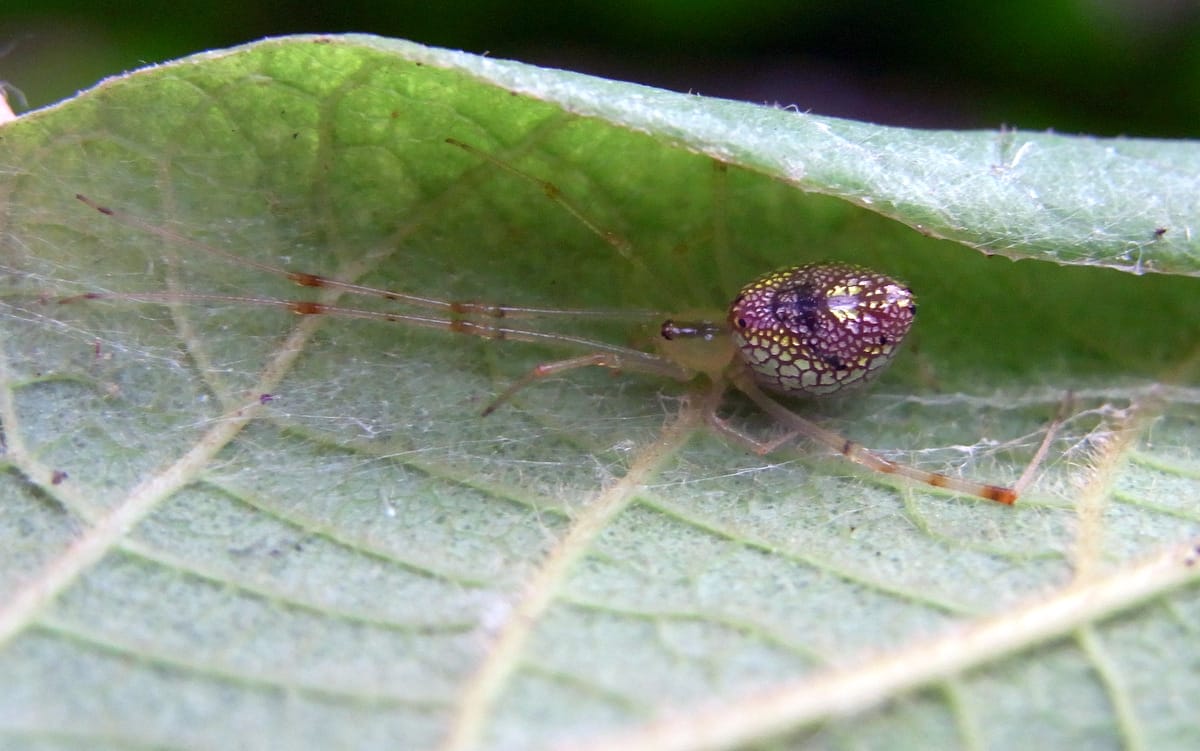
The Mirror Spider, also known as the Sequined Spider, is one of nature’s most dazzling creations. Native to Australia and parts of Asia, this tiny arachnid looks as if it has been sprinkled with bits of silver or mirror-like sequins across its abdomen. It belongs to the Theridiidae family, the same group as cobweb spiders, yet it stands out for its extraordinary reflective scales that shimmer like polished metal.
Identification and Features
The Mirror Spider is small, measuring just about 4–6 millimeters in length, but what it lacks in size it makes up for in brilliance. Its abdomen is decorated with reflective patches made of guanine crystals that act like tiny mirrors. These shiny panels can change in size and brightness depending on the spider’s mood or environment — a rare biological feature that scientists are still studying.
When threatened, the spider can reduce the reflective area, blending seamlessly into its surroundings. This adaptive camouflage makes it both beautiful and elusive.
Behavior and Habitat
Mirror Spiders inhabit forests, gardens, and shrubs, often spinning delicate webs on the undersides of leaves. They are most active during the day, catching small insects such as gnats and flies. Unlike many spiders that rely solely on web vibration, the Mirror Spider also uses its keen eyesight to detect movement around its web.
Females are usually more vibrant than males, and they carefully guard their egg sacs attached to leaves or thin silk structures. Because of their reflective bodies, they are sometimes mistaken for droplets of water or dew — a clever natural disguise against predators.
Interesting Fact
The Mirror Spider’s reflective scales are not just for beauty — they serve as an evolutionary defense mechanism. By reflecting the surrounding light and colors, the spider becomes almost invisible to both predators and prey. Researchers have even studied this natural “mirror armor” for inspiration in developing new light-reflective materials and camouflage technologies.
35. Brazilian Jewel Tarantula (Typhochlaena seladonia)

If spiders could win beauty contests, the Brazilian Jewel Tarantula would take the crown. This breathtakingly colorful tarantula, native to the Atlantic forests of Brazil, looks like it’s been painted by an artist — with hues of metallic blue, pink, green, and gold shimmering across its small body.
Appearance
Despite being tiny (just about 2–3 cm in body length), this species dazzles with iridescent colors that change under light. The carapace glows greenish-gold, while the abdomen flashes violet or magenta tones. It’s one of the smallest yet most visually stunning types of spiders in the world.
Behavior and Habitat
Unlike most tarantulas that dig burrows, the Brazilian Jewel is arboreal. It builds silk retreats inside tree bark crevices, creating trap-like silken doors that protect it from predators. This behavior helps it remain hidden during the day while emerging at night to hunt small insects.
Temperament
These spiders are surprisingly calm but extremely delicate. In the wild, they rarely interact with humans. In captivity, they’re admired but challenging to keep because of their specialized humidity and ventilation needs.
Ecological Role
By feeding on small forest insects, they help balance tropical ecosystems. Their beauty has made them highly sought-after in the exotic pet trade, though conservationists urge responsible breeding to protect wild populations.
36. Red-Knee Tarantula (Brachypelma smithi)
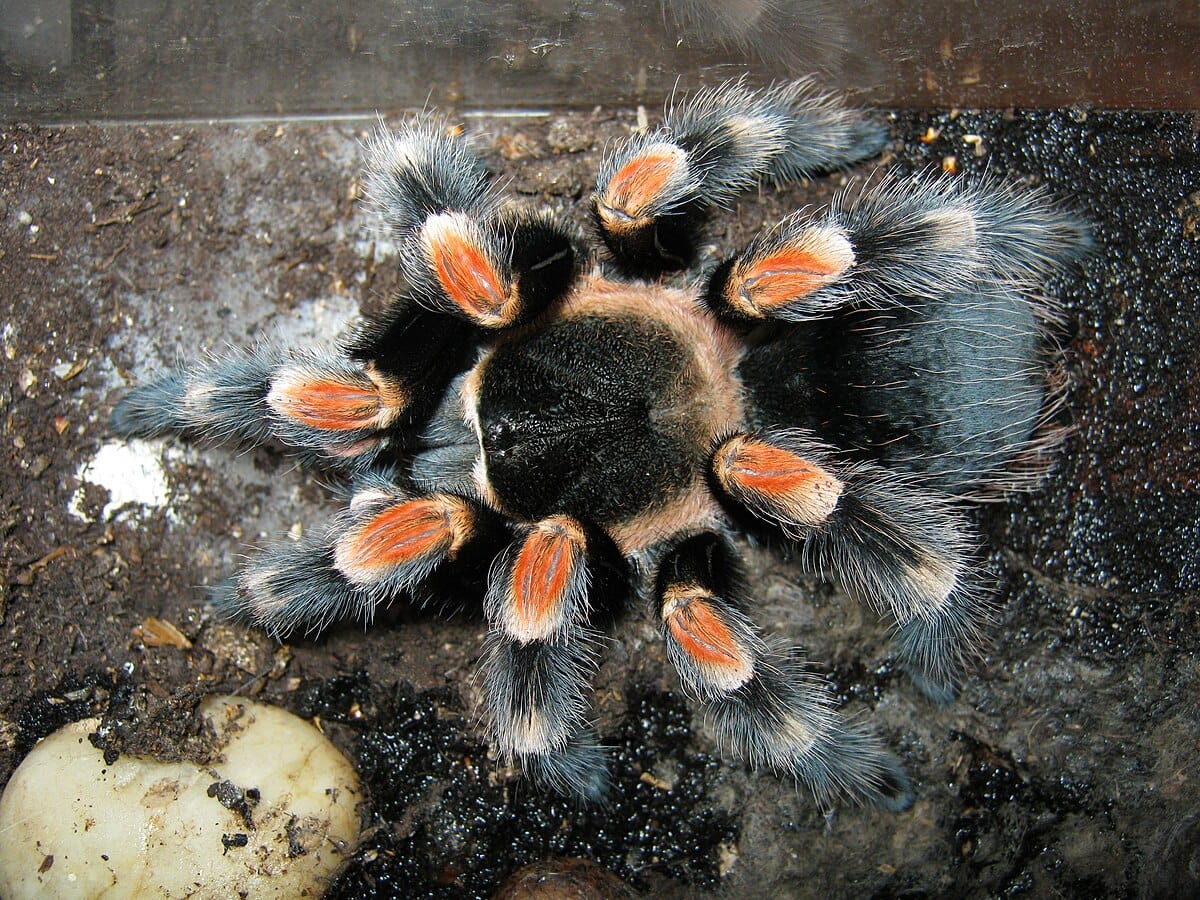
The Red-Knee Tarantula, famous for its fiery orange joints, is one of the most iconic types of spiders from Mexico. Known for its calm nature and stunning looks, it’s often featured in documentaries, movies, and even classrooms as a model of spider charm.
Physical Description
Females can reach up to 6 inches in leg span, covered in black and tan hairs with brilliant red-orange knees. Their slow, deliberate movements give them an oddly graceful presence. Males are smaller and slimmer, with shorter lifespans.
Habitat and Behavior
Native to semi-arid regions of western Mexico, the Red-Knee Tarantula lives in burrows or under rocks. It’s mostly nocturnal, emerging at dusk to hunt beetles, grasshoppers, and other insects. Unlike many spiders, it relies on ambush tactics rather than speed.
Temperament
Gentle and docile, this tarantula is often used as a beginner species in pet keeping. When threatened, it may raise its front legs or flick irritating hairs, but bites are very rare and mild.
Fun Fact
Females can live up to 30 years — an astonishing lifespan among types of spiders. This longevity, along with their temperament, makes them one of the most beloved tarantulas worldwide.
37. Ant-Mimic Spider (Myrmarachne formicaria)
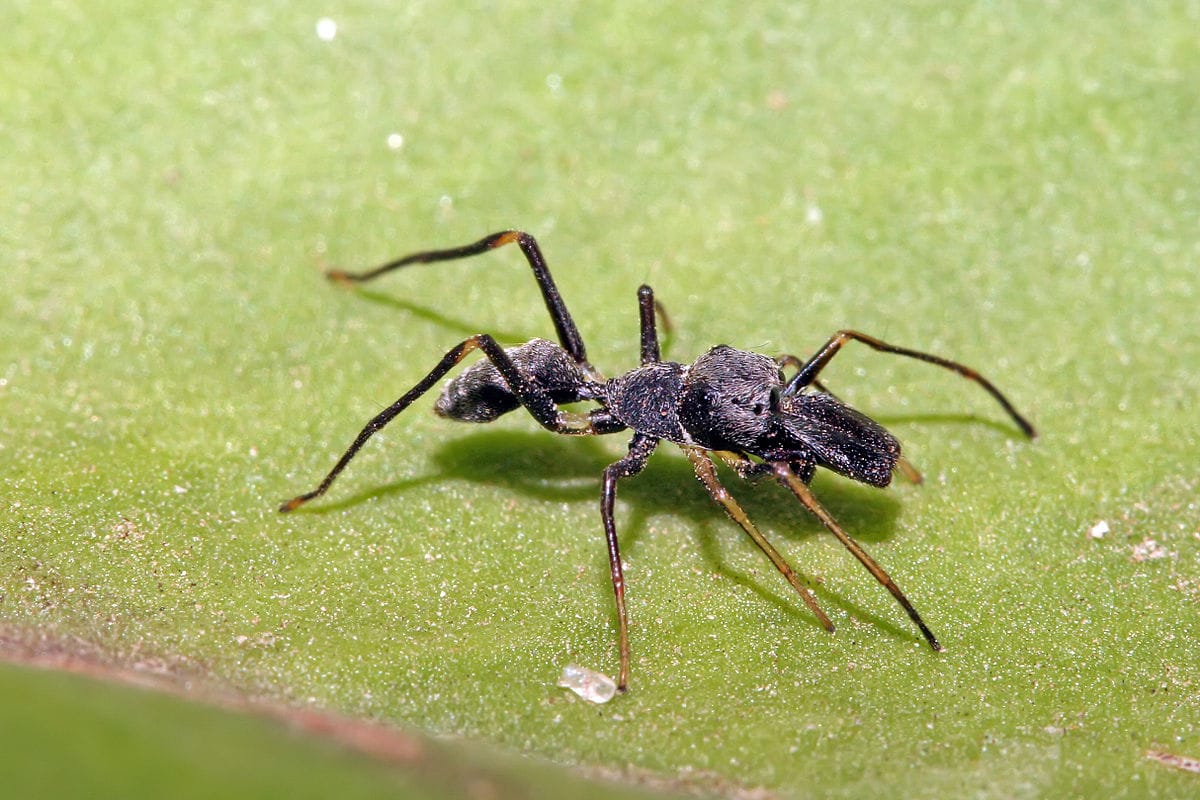
Among all types of spiders, the Ant-Mimic Spider is one of nature’s most fascinating deceivers. This small jumping spider has evolved to look and behave like an ant — not by coincidence, but as a clever survival strategy.
Appearance
Ant-Mimic Spiders have elongated bodies, narrow waists, and movements that perfectly imitate ants. Some even wave their front legs to mimic antennae. Their color varies from reddish-brown to black, depending on the species and region.
Behavior
These spiders are active hunters, not web builders. They use mimicry to infiltrate ant colonies or to avoid becoming prey themselves — since many predators dislike the taste or aggression of real ants. Their jumps are precise, allowing them to pounce on prey with millisecond timing.
Habitat
Found across Europe, Asia, and North America, they prefer open fields, forests, and garden vegetation where ants are common. They build small silk retreats under leaves or bark.
Unique Adaptations
The Ant-Mimic Spider’s disguise isn’t just visual — it behaves like an ant in every way, from erratic walking to frequent body movements. This imitation confuses both predators and prey alike, giving it a perfect blend of offense and defense.
Did You Know?
This spider is a member of the jumping spider family (Salticidae), known for its excellent eyesight and intelligence. It’s one of the best examples of adaptive evolution among all types of spiders on Earth.
38. Ogre-Faced Spider (Deinopis subrufa)
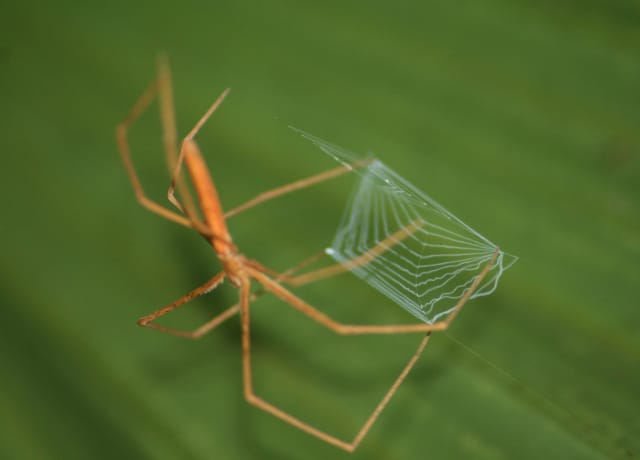
Among the most unusual and fascinating types of spiders, the Ogre-Faced Spider is known for its hauntingly large eyes and remarkable hunting technique. Native to Australia and parts of Africa, this nocturnal predator uses a silk “net” to trap its prey — a strategy that makes it one of the most creative hunters in the spider world.
Appearance
The Ogre-Faced Spider has a long, slender body with spindly legs that give it a stick-like appearance when resting. Its two enormous front-facing eyes, glowing in the dark, are perfectly adapted for night vision. These eyes are among the largest in proportion to body size of any spider species, allowing it to detect the slightest movement in low light.
Behavior and Hunting Method
Rather than spinning a web, Deinopis subrufa weaves a small rectangular net of sticky silk and holds it between its front legs. It suspends itself from a silk line and patiently waits for prey to wander underneath. When an insect passes by, the spider lunges downward and literally throws the net over its victim — a behavior known as “net-casting.”
Habitat
This species thrives in warm, forested areas where it can remain camouflaged during the day by stretching its legs along a twig or branch. Its brown and gray coloring helps it blend seamlessly with bark and foliage.
Fun Fact
The Ogre-Faced Spider rebuilds its eyes every day. Because the cells in its retinas degrade in sunlight, the spider recycles them each night — an incredible adaptation found in no other types of spiders.
39. Six-Eyed Sand Spider (Sicarius hahni)
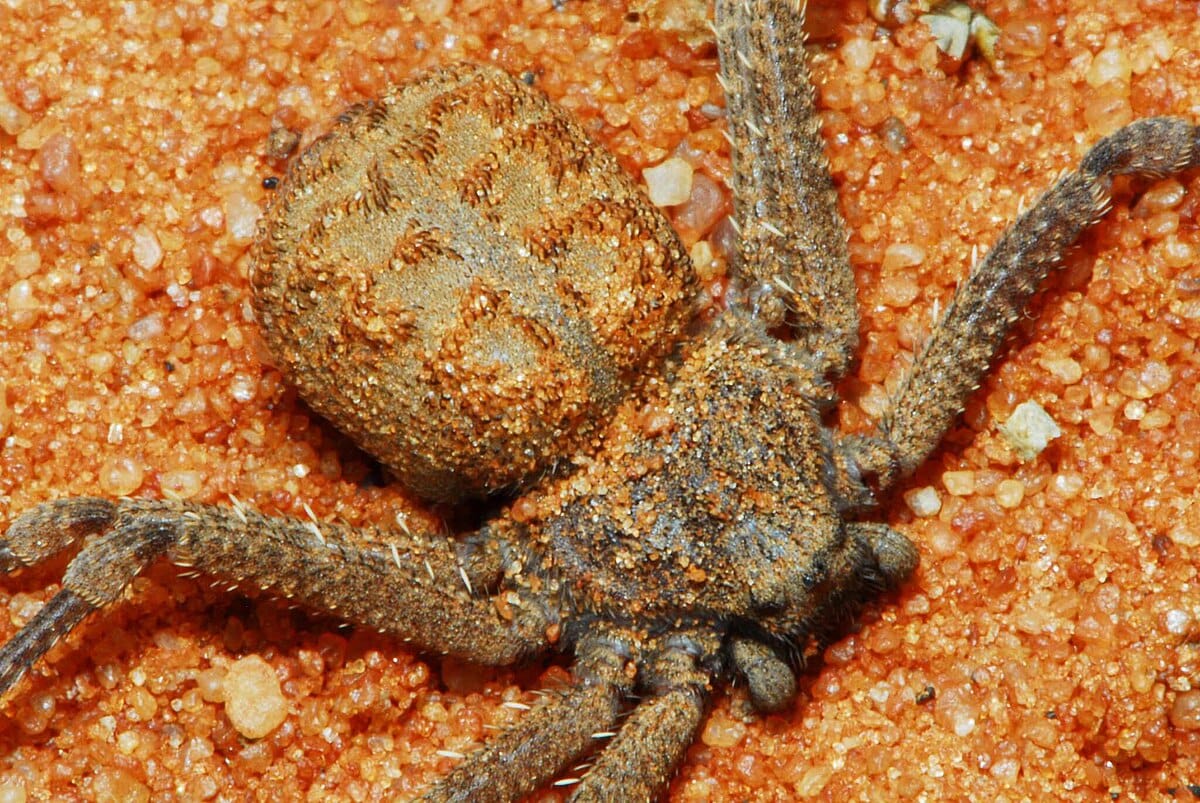
The Six-Eyed Sand Spider is one of the most mysterious and dangerous types of spiders in the world. Found in the deserts of southern Africa, it’s a master of stealth and patience. Its venom is potent, but its reclusive behavior means it’s almost never encountered by humans.
Physical Features
This medium-sized spider has a flat, crab-like body covered in fine hairs that collect sand particles, creating near-perfect camouflage. Unlike most spiders with eight eyes, the Six-Eyed Sand Spider has only six, arranged in pairs that help it detect vibrations and movement.
Behavior
Rather than chase prey, it buries itself just beneath the surface of sand, waiting for insects or small lizards to wander too close. When the target comes within range, it strikes in an instant, injecting venom that quickly immobilizes its meal.
Venom
Its venom contains necrotic agents capable of destroying tissue, but bites are extremely rare. In fact, there have been only a handful of documented cases involving humans — and none from spiders attacking deliberately.
Habitat and Ecology
This spider inhabits the dry, sandy regions of Namibia, South Africa, and Botswana. It plays an important ecological role by controlling insect populations in harsh desert ecosystems.
Interesting Fact
Because of its sand-colored camouflage and stealthy lifestyle, it’s sometimes nicknamed the “assassin of the desert.” Few types of spiders are better adapted to surviving extreme heat and dryness.
40. Feather-Legged Orb Weaver (Uloborus plumipes)
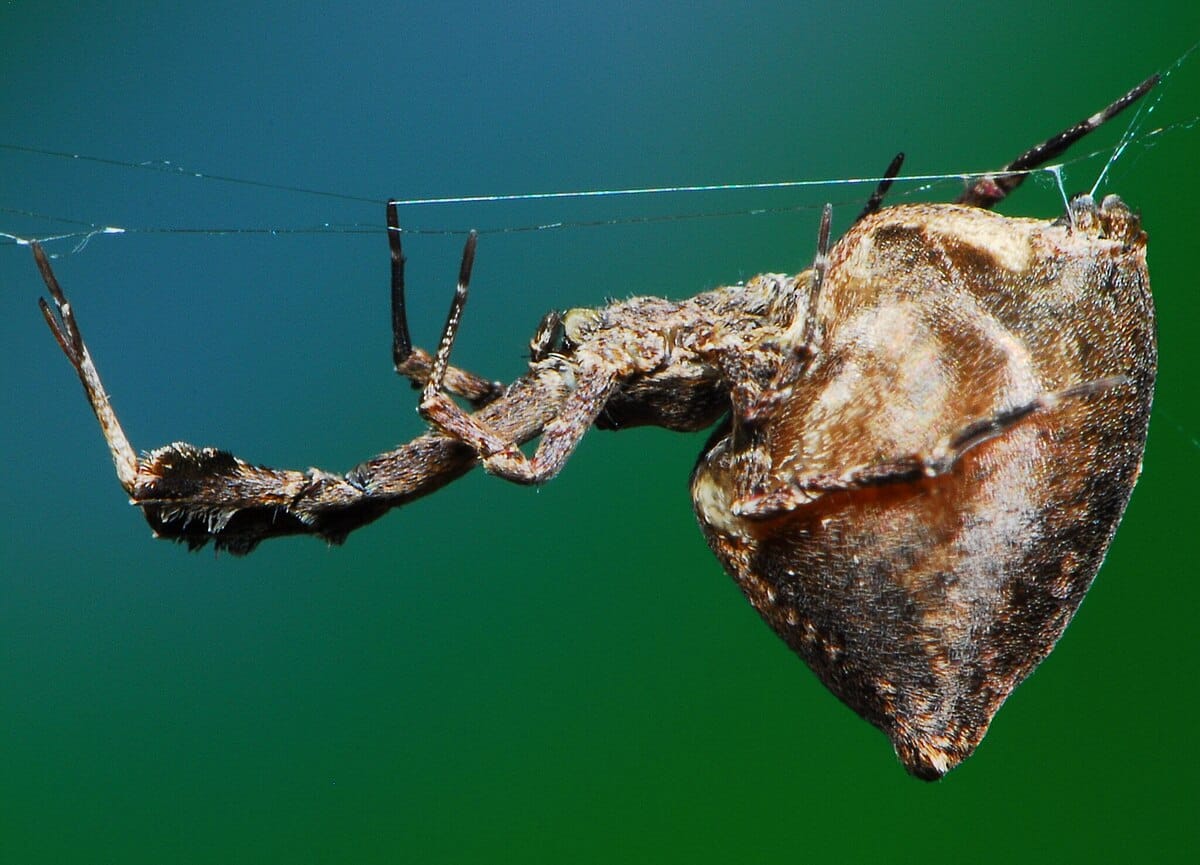
Delicate yet effective, the Feather-Legged Orb Weaver is one of the most graceful types of spiders found in homes and gardens. It’s easily recognized by its fuzzy legs that resemble soft feathers and by the horizontal webs it weaves indoors or in shaded outdoor corners.
Appearance
This small spider has a slender body, measuring about 5–6 mm in length, with silvery gray or brown markings. The “feathered” appearance of its legs comes from dense tufts of fine hairs used for sensory detection rather than defense.
Unique Feature
What makes this spider fascinating is that it’s non-venomous. Belonging to the family Uloboridae, it’s one of the few types of spiders that doesn’t use venom to subdue its prey. Instead, it relies on sticky, wool-like silk to entangle and crush insects mechanically.
Behavior
Feather-Legged Orb Weavers are shy and prefer quiet environments. They spin horizontal or slightly tilted orb webs, often in corners of attics, garages, or garden sheds. When prey gets caught, the spider wraps it tightly and feeds by secreting digestive enzymes.
Fun Fact
Because they lack venom glands, their silk is extra strong — among the toughest produced by any spider. This adaptation makes them both harmless to humans and incredibly efficient hunters.
41. Ladybird Mimic Spider (Paraplectana duodecimmaculata)
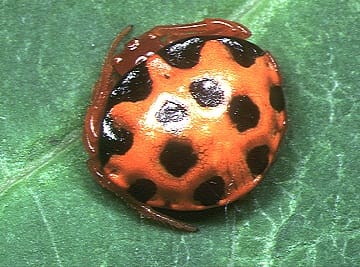
At first glance, you might mistake this spider for a ladybug — and that’s exactly what it wants. The Ladybird Mimic Spider is one of the most colorful types of spiders in Africa, using mimicry as a brilliant form of protection.
Appearance
Small and round, this orb-weaver has a bright red, orange, or yellow abdomen adorned with black spots, closely resembling a ladybird beetle. Its legs are short and dark, helping it maintain the illusion of being a harmless insect rather than a predator.
Habitat and Distribution
Found throughout tropical regions of Africa, these spiders typically live on shrubs, leaves, and flower stems where ladybugs are common. Their mimicry confuses predators like birds and lizards that have learned to avoid the foul-tasting beetles.
Behavior
Like most orb-weavers, the Ladybird Mimic Spider builds circular webs to capture small flying insects. During the day, it often rests motionless, blending perfectly with its surroundings. At night, it becomes active, repairing its web or hunting.
Did You Know?
This is one of the few types of spiders whose coloration evolves to match local ladybird species, demonstrating a rare example of regional mimicry in arachnids.
42. Spitting Spider (Scytodes thoracica)
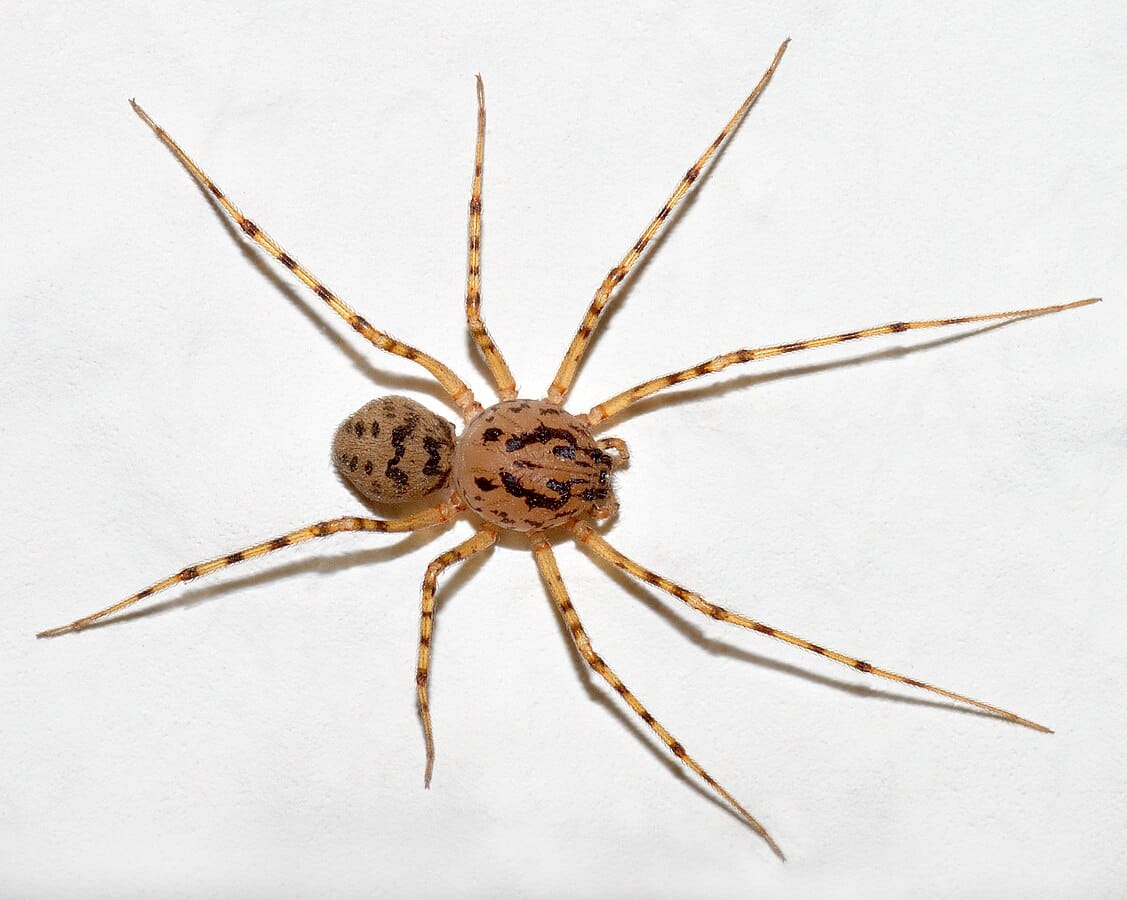
The Spitting Spider is one of nature’s most inventive hunters and a standout among all types of spiders for its unusual attack method. Instead of relying solely on silk or venom, it “spits” a glue-like substance at its prey, effectively immobilizing it in milliseconds.
Physical Description
These medium-sized spiders have a characteristic domed head and long, delicate legs. Their bodies are pale yellow or tan with brown speckles that help them blend into indoor walls or tree bark. The pattern gives them a marbled, almost artistic look.
Hunting Mechanism
When hunting, the Spitting Spider ejects a sticky, venomous silk from its fangs in a rapid zigzag motion, coating its prey from a distance. Once the prey is trapped, the spider moves in to deliver a venomous bite that completes the job.
Habitat
Common across warm regions worldwide, they often live indoors, behind furniture, or in dark corners. They’re not aggressive toward humans and play a valuable role in controlling other pests, including mosquitoes and flies.
Venom and Safety
Their venom is mild, and they rarely bite humans. Because of their preference for solitude and stealth, they’re considered one of the most beneficial types of spiders to have around the house.
Fun Fact
Spitting Spiders can target moving prey with incredible accuracy — adjusting their aim mid-shot. This makes them one of the few arachnids capable of predicting movement before attacking.
43. Happy Face Spider (Theridion grallator)

The Happy Face Spider is one of the most delightful and unusual spiders on the planet. Native to the Hawaiian Islands, this tiny species gets its name from the vibrant, smiley face–like markings on its abdomen — which can resemble a grinning emoji, a pair of eyes, or even abstract patterns depending on the individual. It’s a living example of how playful and unpredictable nature can be.
Identification and Features
The Happy Face Spider is quite small, measuring only about 5 millimeters in length. Its translucent yellow body is marked with bright red, black, and white spots on its abdomen, creating unique “faces” — no two spiders look exactly alike. Some may have full smiling faces, while others display dots or curved lines that resemble expressions.
These spiders belong to the Theridiidae family, the same as cobweb and mirror spiders, and are known for their delicate silk webs and intricate hunting methods.
Behavior and Habitat
Happy Face Spiders live on the undersides of leaves in Hawaii’s rainforests, particularly on the islands of Maui, Oahu, and the Big Island. They prefer humid, shaded environments where they can build small, irregular webs to catch insects like gnats, fruit flies, and mosquitoes.
Unlike many other spiders, they are diurnal (active during the day), often resting on the underside of leaves with their legs spread wide, completely blending in with the foliage. Their small size and natural camouflage make them extremely hard to spot in the wild.
Interesting Fact
The Happy Face Spider’s markings are a form of genetic polymorphism — meaning their patterns are determined by genetics and can vary even within the same population. Scientists believe this variation helps them avoid predators by making it harder for birds or insects to recognize them as prey.
Even more fascinating, the Happy Face Spider has become a cultural icon in Hawaii, symbolizing the islands’ unique biodiversity and the joyful spirit of nature itself.
44. Tiger Spider (Poecilotheria regalis)
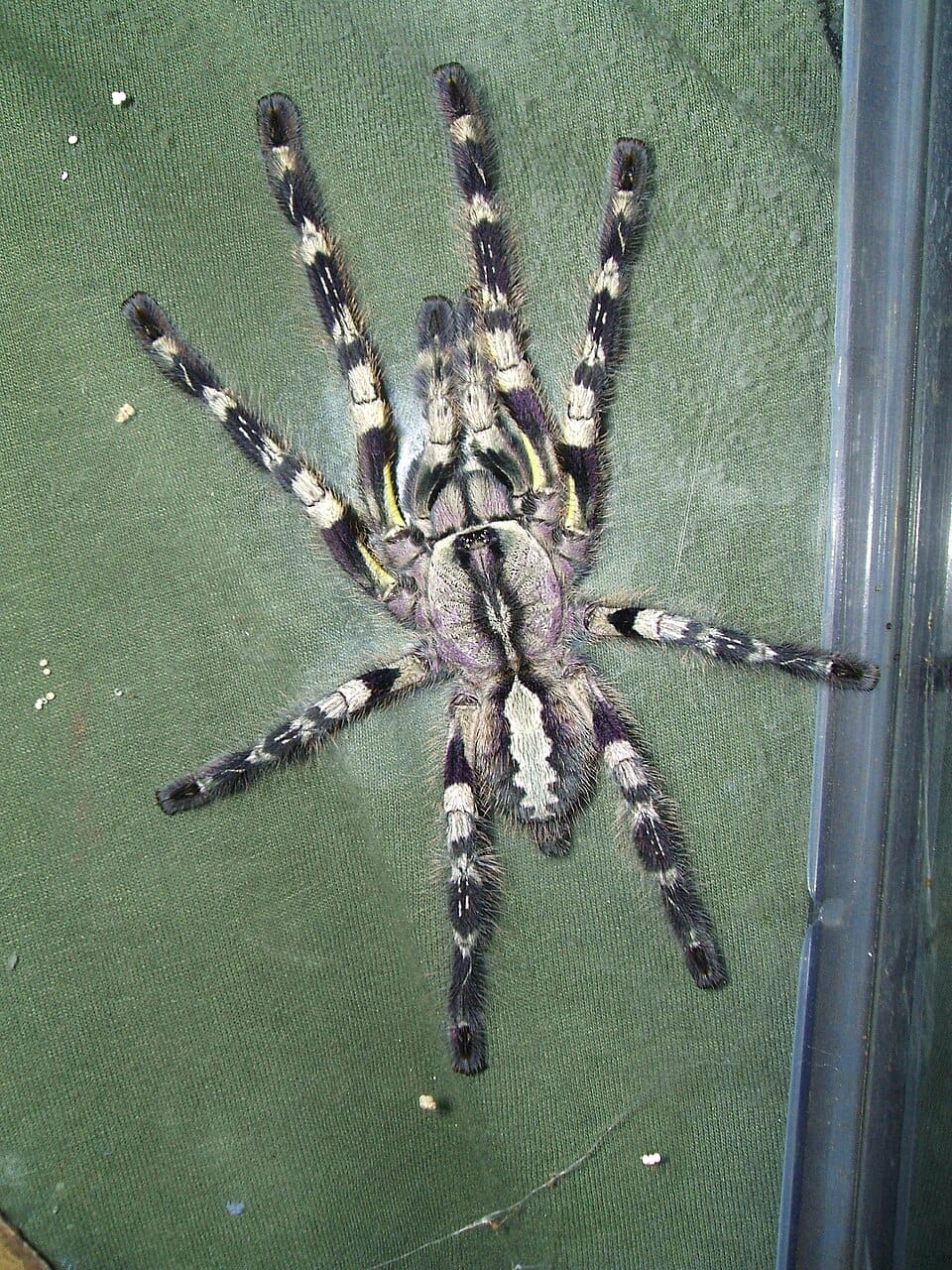
The Tiger Spider, or Indian Ornamental Tarantula, is one of the most visually stunning species in the Poecilotheria genus. Native to India and Sri Lanka, this arboreal tarantula is known for its distinctive black and white markings and lightning-fast movements. It’s a favorite among exotic pet enthusiasts, though it’s best admired from a safe distance due to its defensive temperament.
Identification and Features
This tarantula can grow up to 7 inches in leg span, making it one of the larger species. Its intricate color patterns of silver, black, and gray stripes resemble the markings of a tiger — hence its name. Unlike ground-dwelling tarantulas, the Tiger Spider has long, agile legs that help it climb trees and walls with ease.
Behavior and Habitat
Tiger Spiders are arboreal, spending most of their lives inside tree hollows or under loose bark. They are fast, secretive, and often defensive when disturbed. Their venom, while not deadly to humans, can cause intense pain and swelling.
Interesting Fact
The Tiger Spider uses its speed and camouflage as primary defenses instead of relying on aggression. Despite its fierce appearance, it prefers to retreat rather than bite — making it more misunderstood than dangerous.
45. Golden Huntsman Spider (Beregama aurea)
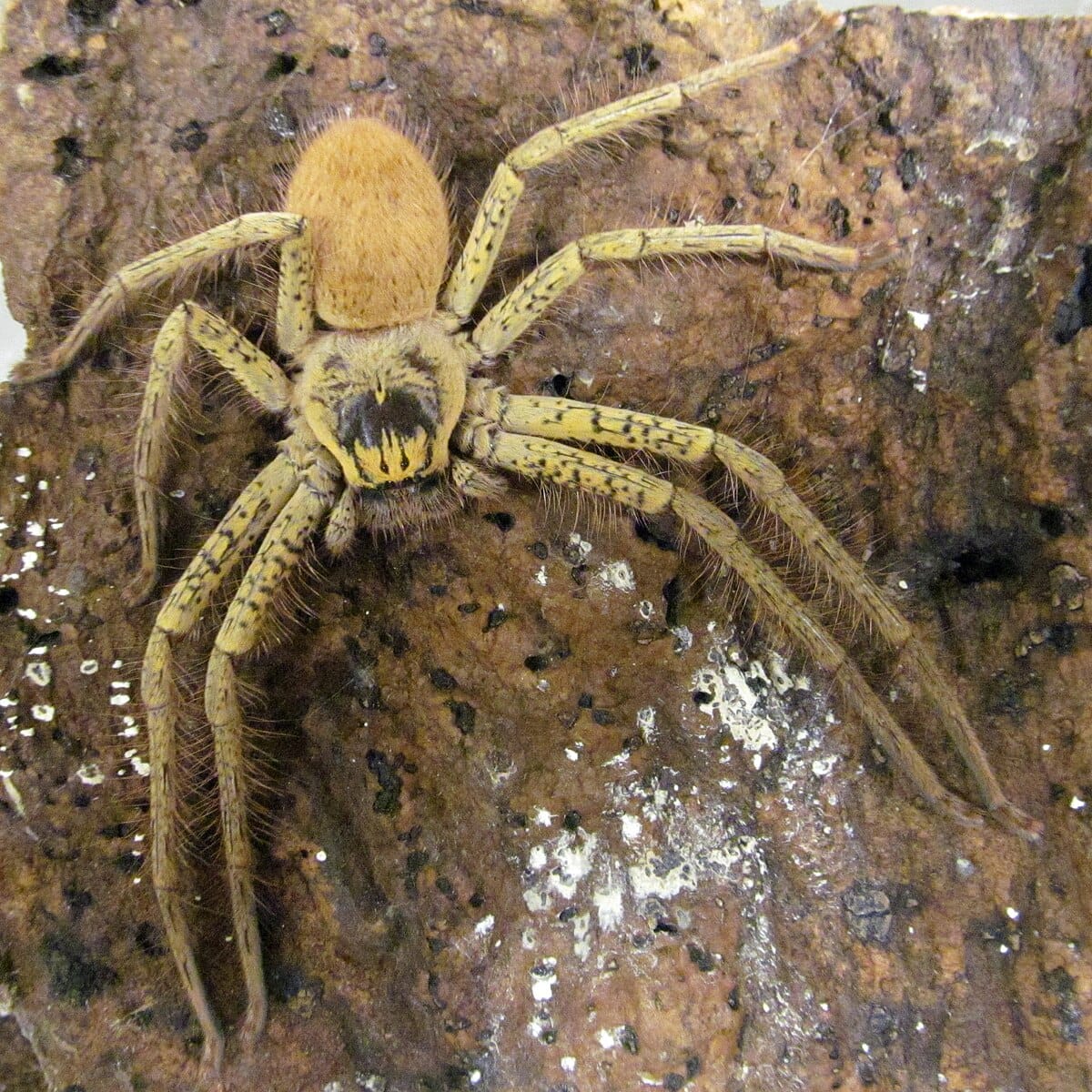
The Golden Huntsman Spider is a magnificent species found in northern Australia. It belongs to the Sparassidae family, known for their speed and ability to hunt without webs. This particular species stands out with its glowing golden hue, agile movements, and gentle disposition — often making its way into homes and gardens.
Identification and Features
Golden Huntsmans have a broad, flat body and legs that can reach up to 6 inches in span. Their color ranges from bright gold to orange-yellow, often blending into the bark of trees or wooden surfaces. Unlike many other spiders, they rely on ambush tactics rather than webs to capture prey.
Behavior and Habitat
These spiders are nocturnal hunters that roam through forests, woodlands, and even residential areas. They feed on cockroaches, moths, and other small insects, making them helpful pest controllers. Though large in size, they are generally harmless and non-aggressive toward humans.
Interesting Fact
The Golden Huntsman’s flattened body shape allows it to slip behind thin surfaces like bark or picture frames, earning it the nickname “flat spider” among Australians.
46. Fringed Ornamental Tarantula (Poecilotheria ornata)
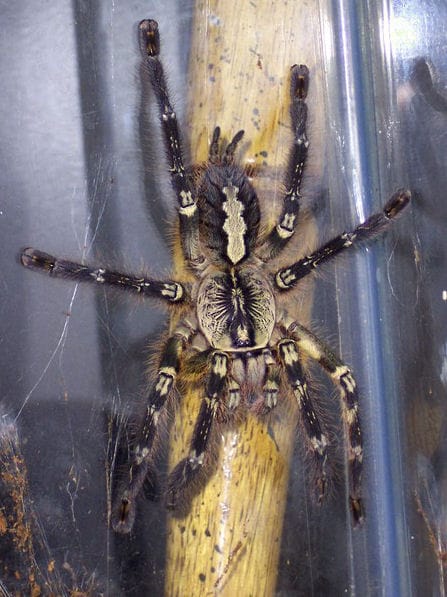
Native to Sri Lanka, the Fringed Ornamental Tarantula is another breathtaking species within the Poecilotheria genus. This arboreal spider is prized for its striking coloration and lightning-fast reflexes. Though beautiful, it’s known for having one of the more potent venoms among tarantulas, making it a species that should be admired, not handled.
Identification and Features
The Fringed Ornamental boasts a large body (up to 8 inches in leg span) covered with silvery-blue hairs and ornate yellow banding on its legs. Its body patterns help it blend seamlessly into tree bark, offering both camouflage and aesthetic allure.
Behavior and Habitat
These spiders dwell in hollow trees, emerging mostly at night to hunt flying insects. In captivity, they require tall enclosures with plenty of vertical climbing space. They are shy but quick to defend themselves when cornered.
Interesting Fact
Poecilotheria tarantulas, including the Fringed Ornamental, communicate with subtle body postures and vibrations — a unique behavioral trait that helps them avoid unnecessary fights in the wild.
47. Blue Tarantula (Haplopelma lividum)
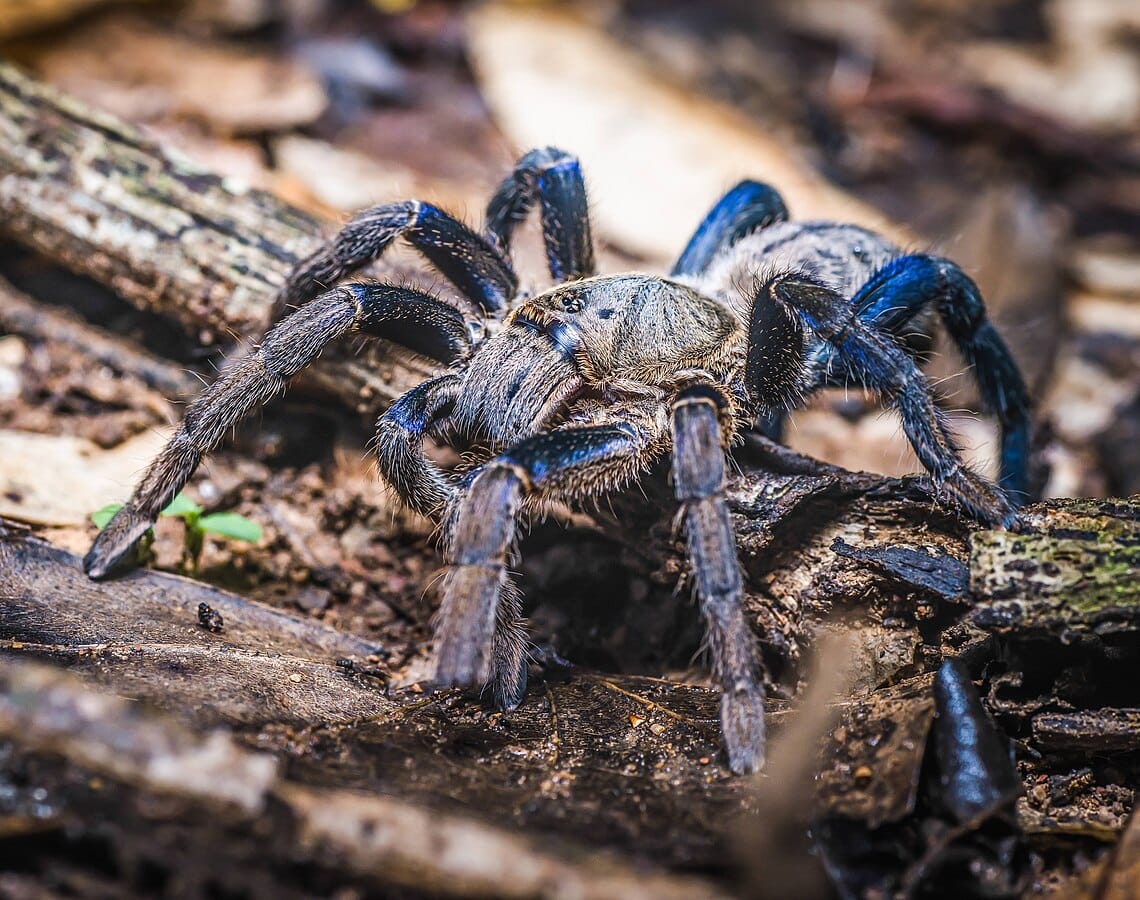
The Blue Tarantula, also known as the Cobalt Blue Tarantula, is one of the most visually stunning spiders in the world. Native to the tropical forests of Myanmar and Thailand, this species is famous for its metallic cobalt-blue sheen that glows under light — making it a favorite among exotic tarantula collectors.
Identification and Features
This medium-sized tarantula reaches up to 5 inches in leg span. While its body is dark brown, the legs shimmer with an intense blue hue. The color isn’t from pigments but from microscopic hair structures that reflect light — a phenomenon called structural coloration.
Behavior and Habitat
The Blue Tarantula is a burrowing species that spends most of its time underground. It’s known for being defensive and quick, relying on its speed rather than aggression. Its diet mainly includes insects, small frogs, and other invertebrates.
Interesting Fact
Despite its beauty, this tarantula is not ideal for beginners. It’s highly reclusive and prefers to stay hidden — proving that in the spider world, the most stunning creatures often remain unseen.
48. Northern Tree Funnel-Web Spider (Hadronyche formidabilis)
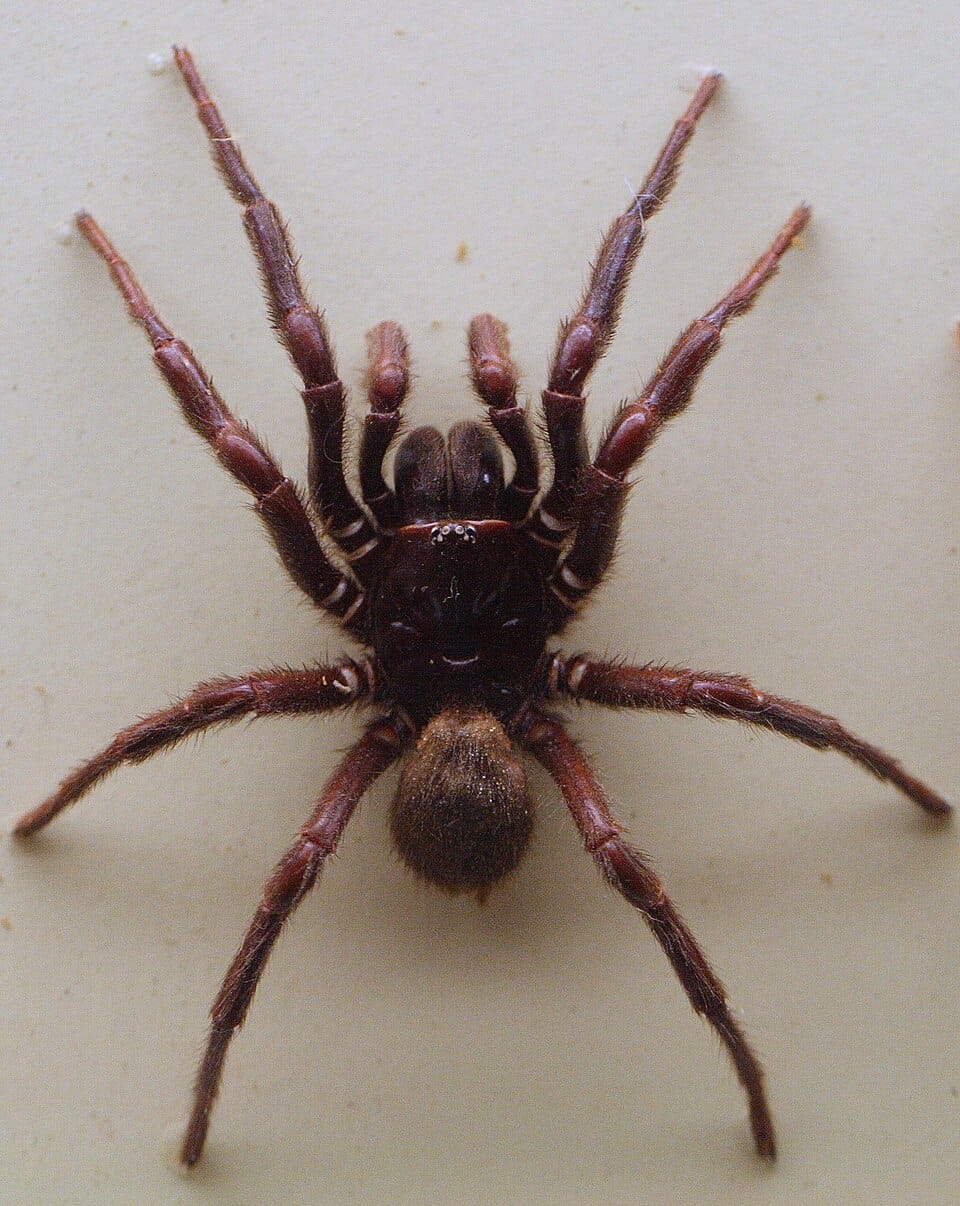
The Northern Tree Funnel-Web Spider is one of the most formidable arachnids in Australia — and possibly the world. Belonging to the Atracidae family, this species is closely related to the infamous Sydney Funnel-Web but is more arboreal, meaning it prefers to live in trees rather than underground burrows. Despite its dangerous reputation, this spider plays a vital role in balancing insect populations in Australia’s forests.
Identification and Features
This large, glossy-black spider can reach up to 5 centimeters in body length, with strong, powerful fangs capable of piercing through soft materials. Its robust body and thick legs give it a sturdy, almost armored appearance. The body surface is often shiny and covered with fine hairs that reflect a deep blue or purple hue under light.
Behavior and Habitat
The Northern Tree Funnel-Web inhabits rainforests and moist woodland areas along the eastern coast of Australia. It often shelters in tree hollows, crevices, and decaying wood. True to its name, it spins funnel-shaped webs where it hides at the narrow end, waiting for prey to wander in. When disturbed, it adopts a defensive posture, raising its front legs and exposing its fangs — a clear warning to predators.
Despite its intimidating look, bites to humans are extremely rare, as this species tends to avoid human contact. Antivenom for the Sydney Funnel-Web is also effective against this spider’s venom.
Interesting Fact
The Northern Tree Funnel-Web’s venom is among the most potent of all spiders, but it’s also being researched for potential medical uses — including pain management and heart disease treatments.
49. Wasp Spider (Argiope bruennichi)
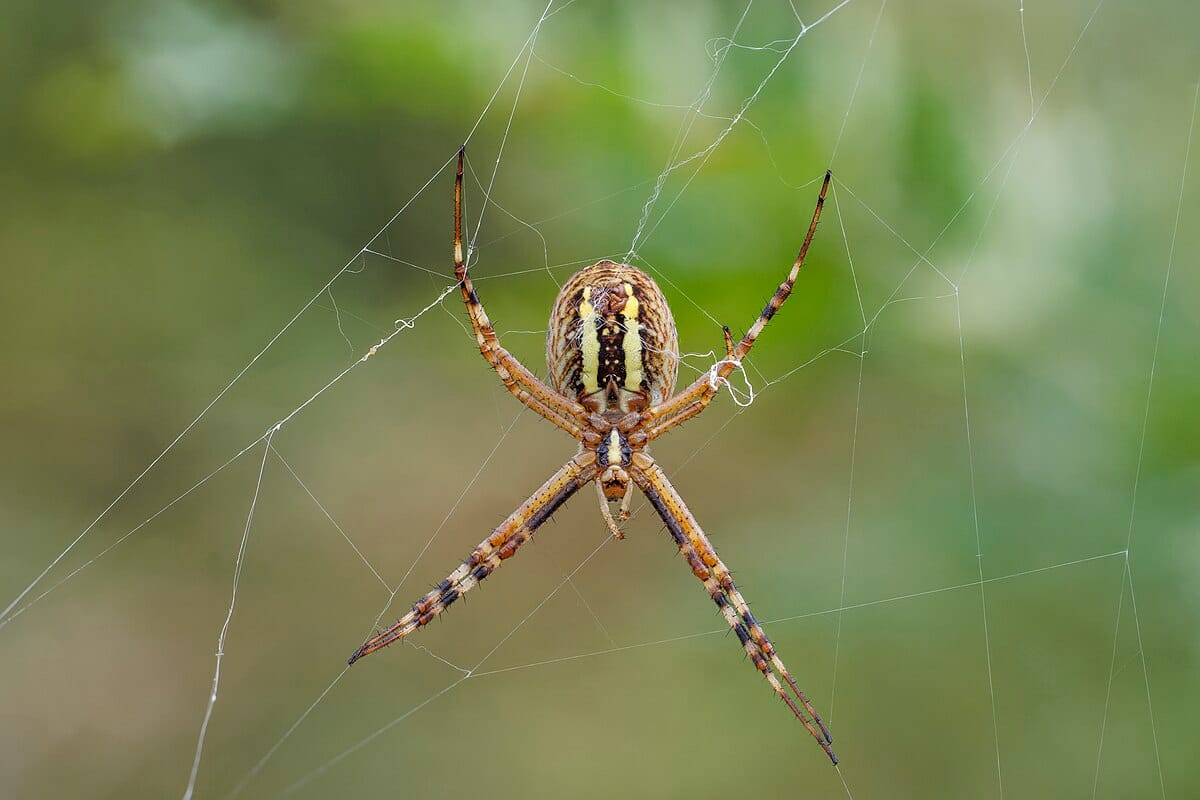
The Wasp Spider is a striking orb-weaver species easily recognized by its bright yellow and black stripes, which mimic the appearance of a wasp. This clever disguise not only deters predators but also helps it thrive in meadows, grasslands, and gardens across Europe and Asia. The Wasp Spider is a perfect example of how mimicry in nature can serve as a powerful survival strategy.
Identification and Features
This spider features a round abdomen patterned with vivid yellow, white, and black bands. Females are much larger, measuring up to 1.5 inches, while males are significantly smaller and less colorful. The legs are long and banded, complementing the bold body pattern.
One of its most fascinating traits is the web itself. The Wasp Spider builds large, orb-shaped webs with a distinctive zigzag silk structure called a stabilimentum running through the center. Scientists believe this pattern reflects ultraviolet light, attracting insects like grasshoppers and bees.
Behavior and Habitat
The Wasp Spider prefers sunny, open areas with tall grass. It’s a patient predator, sitting motionless in its web until an insect becomes ensnared. Once caught, it wraps its prey in silk and delivers a venomous bite to immobilize it.
Interesting Fact
Despite its intimidating look, the Wasp Spider’s venom poses no threat to humans. It’s one of the most photographed spiders in Europe thanks to its wasp-like beauty and spectacular web design.
50. Green Orb-Weaver (Araniella cucurbitina)
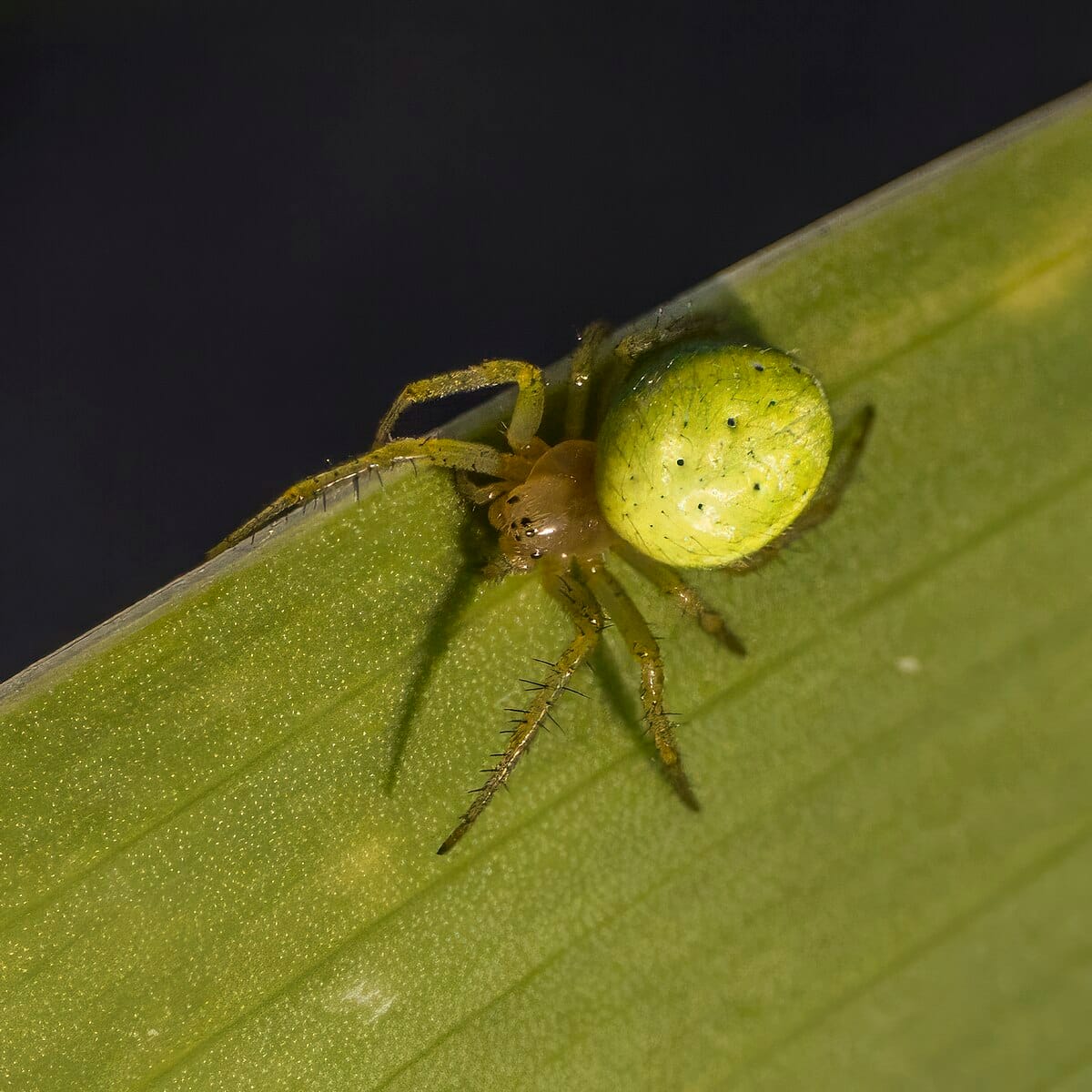
The Green Orb-Weaver, also known as the Cucumber Green Spider, is a small yet captivating species commonly found throughout Europe and Asia. Its delicate green body and peaceful temperament make it one of the most charming members of the orb-weaver family.
Identification and Features
This tiny spider measures just 4–6 millimeters long. Its translucent green body helps it blend seamlessly with leaves and stems — a perfect camouflage for survival. A small red spot near the back of its abdomen helps identify the species, making it distinct from other green spiders.
Behavior and Habitat
Green Orb-Weavers construct small, circular webs among shrubs, hedgerows, and gardens. They’re most active from spring to autumn, preying on small flying insects such as gnats and aphids. During winter, females lay eggs in silken sacs attached to foliage, ensuring the next generation hatches when the weather warms.
Interesting Fact
The spider’s green color comes from bile pigments, which fade shortly after death — one of the reasons it’s difficult to preserve their vivid coloration in scientific collections.
FAQ’s
1. What is the most harmless spider?
The most harmless spider is the common house spider (Parasteatoda tepidariorum). Despite living close to humans, it poses no danger at all. Its fangs are too small to pierce skin effectively, and its venom is incredibly mild. These spiders actually help by eating mosquitoes, flies, and other pests around your home.
2. What is the cutest spider called?
The Peacock Spider (Maratus species) easily wins the title of the cutest spider. Native to Australia, males have bright, colorful abdomens that they lift and wave during courtship dances. Their big eyes and tiny bodies make them look more like cartoon characters than predators.
3. What is the most common spider in the UK?
The most common spider in the UK is the Giant House Spider (Eratigena duellica). You’ll often see them in homes during autumn when males wander in search of females. Although they look intimidating, they’re harmless and play an important role in controlling insects indoors.
4. What spider is most poisonous?
The Brazilian Wandering Spider (Phoneutria species) holds the record as the world’s most venomous spider. Its bite can cause severe symptoms in humans, but deaths are extremely rare thanks to medical treatment. Most spiders, however, have venom that’s only effective on small insects—not people.
5. Do spiders leave you alone when you sleep?
Yes, absolutely. Spiders aren’t interested in humans while you sleep. They prefer quiet, dark corners and avoid large, warm, moving objects like people. The myth about spiders crawling into your mouth at night is pure fiction!
6. What is the least scariest spider?
The Jumping Spider (Salticidae family) is often considered the least scary. Their curious, almost playful behavior and expressive eyes make them surprisingly endearing. Many even seem to “look around” and observe humans, showing a level of awareness that fascinates scientists.
7. What is the prettiest spider ever?
The Green Lynx Spider (Peucetia viridans) is stunning with its bright green body, long spiny legs, and red facial markings. Found in gardens across the Americas, it’s both beautiful and beneficial—feeding on harmful pests while blending perfectly with leaves and flowers.
8. Why do jumping spiders wave at you?
When a jumping spider waves, it’s actually using body language to communicate. Males wave to attract females, while others may wave their legs defensively if they feel threatened. It’s not a friendly “hello,” but it’s certainly an adorable behavior to witness.
9. What is a candy spider?
The “Candy Spider” isn’t a scientific species but a nickname often used for bright-colored orb-weaver spiders or decorative toy spiders. Some real spiders, like certain crab spiders, have vivid colors that make them look like little candies sitting on flowers.
10. Can spiders feel pain?
Spiders can sense damage and respond to danger, but their nervous systems are much simpler than ours. Scientists believe they don’t experience pain in the emotional way humans or mammals do. They react reflexively to injury but don’t suffer emotionally from it.
11. What attracts spiders to your bedroom?
Spiders come into bedrooms mainly for food and shelter. If there are insects, clutter, or dark hiding spots, spiders may take advantage of the environment. They’re not attracted to humans themselves but to the smaller bugs that share your space.
12. What spider looks like a giant ant?
The Ant-Mimicking Spider (Myrmarachne species) is a fascinating type of jumping spider that perfectly imitates ants. It moves, waves its legs, and even copies ant-like behavior to avoid predators and sneak up on prey. It’s one of nature’s most clever disguises.
13. Why should you not squish a spider?
Squishing a spider kills an important insect predator and can release eggs or attract more pests. It’s better to gently catch and release them outdoors. Spiders help keep ecosystems balanced—even inside your house, they’re quietly working for free pest control.
14. What smell do spiders hate?
Spiders dislike strong scents like peppermint, eucalyptus, and citrus. Using essential oils with these aromas can help deter them from corners or windows. Vinegar also works well because of its sharp odor, which interferes with their sense of direction.
15. Should I sleep in my bed if I found a spider?
Yes, you can safely sleep in your bed. Once disturbed, the spider will most likely retreat and hide. If you’re uncomfortable, simply remove it with a cup and paper, then release it outside. They rarely linger near humans once noticed.
16. What is the scariest spider?
The Goliath Birdeater (Theraphosa blondi) from South America is often labeled the scariest because of its massive size—up to 11 inches across! Despite its name, it rarely eats birds and is not dangerous to humans. Its intimidating look hides a calm nature.
17. What are spiders afraid of?
Spiders fear vibrations, bright lights, and large movements. They instinctively avoid predators like birds, lizards, and even humans. Clapping, gentle tapping, or simply turning on a light often sends them scurrying away.
18. How many eyes do spiders have?
Most spiders have eight eyes, though some have six or fewer depending on the species. Their eye arrangement helps scientists identify them. Jumping spiders have excellent vision, while others rely more on vibrations and touch than sight.
19. What is a coke spider?
The “Coke Spider” is a slang term from an old urban myth about spiders found in soda cans—completely untrue. There’s no such thing as a species called a Coke Spider. Always be careful with viral stories that sound too strange to be real!
20. What is a Joker spider?
The Joker Spider is a nickname given to a few colorful jumping spiders whose facial patterns resemble the grin of the comic-book character “Joker.” They’re harmless and adored by photographers for their vivid colors and expressive looks.
21. Why do spiders stare at you?
Spiders don’t really “stare” at humans out of curiosity — at least not the way we do. However, jumping spiders have excellent vision and often turn their heads to follow movement. When one seems to look at you, it’s actually tracking your motion, assessing whether you’re a threat or something interesting.
22. How do spiders mate?
Spider mating is a delicate process. The male deposits sperm on a small web, then transfers it to his pedipalps — tiny arm-like structures — before carefully approaching the female. In some species, males risk being eaten afterward, which is why courtship involves careful dances or vibrations to show peaceful intent.
23. Can spiders hear things?
Spiders don’t have ears, but they can sense sound vibrations through the tiny hairs on their legs and bodies. These hairs pick up air movement and ground vibrations, allowing spiders to “hear” approaching predators or prey in a unique way that doesn’t rely on traditional hearing.
24. What is the fattest spider ever?
The Goliath Birdeater (Theraphosa blondi) is the heaviest spider known, weighing up to 175 grams (about 6 ounces). Found in the rainforests of South America, it’s a gentle giant despite its terrifying size and name. It mostly feeds on insects, frogs, and small mammals.
25. What is a dancing spider?
The term “dancing spider” usually refers to the Peacock Spider (Maratus species). Males perform intricate, colorful dances to attract females, waving their legs and lifting their bright abdominal flaps. These charming displays are so animated that they’ve earned viral fame worldwide.
26. What is the kindest spider in the world?
The Jumping Spider is often called the “kindest” because of its curious and non-aggressive nature. These little spiders are more likely to observe humans than to bite, and they show surprising intelligence, sometimes even recognizing patterns and learning from experience.
27. Do spiders have dreams?
Recent research suggests they might! Scientists have observed twitching and leg movements in sleeping jumping spiders that resemble REM sleep in mammals. While we can’t know for sure what they dream about, it’s possible spiders experience basic visual memories when resting.
28. Can spiders listen to music?
Not in the way we do. Spiders don’t perceive melody or rhythm, but they can sense vibrations caused by sound waves. Loud or deep music can make them feel the movement in their environment, though they don’t understand it as “music.”
29. Can spiders sense my fear?
Spiders can’t smell or detect fear the way dogs or other mammals might. However, they are extremely sensitive to movement and vibration. If you move quickly or breathe heavily near them, they may interpret that as danger and retreat quickly.
30. Why do spiders twerk?
When you see a spider “twerking,” it’s usually part of a mating or defensive behavior. Jumping spiders, for example, wiggle their abdomens to signal to potential mates or to warn off threats. It’s nature’s version of a dance-off, not a modern TikTok imitation!
31. Is there a rainbow spider?
Yes! The Rainbow Peacock Spider (Maratus robinsoni and related species) displays brilliant rainbow-like colors on its abdomen. The male uses these shimmering hues during courtship displays to attract females, making it one of the most visually stunning spiders on Earth.
32. What is a butterfly spider?
“Butterfly spider” isn’t a scientific term, but it’s often used to describe brightly colored jumping spiders or orb-weavers that resemble butterflies in color and movement. Some tropical species even have wing-like patterns on their bodies that help deter predators.
33. Do vampire spiders exist?
Yes, in a way! The Vampire Jumping Spider (Evarcha culicivora) from Africa feeds on blood indirectly. It doesn’t bite humans but preys on mosquitoes that have recently fed on human blood. This makes it one of nature’s most fascinating — and harmless — “vampires.”
34. What is the cutest spider?
Again, the Peacock Spider wins hands down. With its big eyes, vibrant patterns, and adorable dance moves, it’s widely considered the cutest spider species. Even people who fear spiders often admit these tiny dancers are irresistibly charming.
35. What is a blind spider?
Blind Cave Spiders are real — they’ve evolved in total darkness, losing their eyesight completely. Found in deep caves in countries like Australia and Venezuela, these spiders rely entirely on touch and vibration to navigate and hunt.
36. Are banana spiders poisonous?
The term “banana spider” can refer to a few different species. The bright yellow Golden Silk Orb-Weaver (Nephila clavipes) is harmless to humans, while the Brazilian Wandering Spider, sometimes called a banana spider too, has strong venom. Most banana spiders you see are harmless web-weavers.
37. Which spider has the most kills?
In terms of hunting success, the Wolf Spider (Lycosidae) family is among the deadliest. They don’t spin webs — they stalk and ambush their prey directly, catching hundreds of insects in their lifetime. Fast, efficient, and fearless, they’re the apex predators of the spider world.
38. How many eyes does a spider have?
Most spiders have eight eyes, arranged in different patterns depending on the family. Some species have six, four, or even two. These eye patterns help scientists identify them. Jumping spiders use their large front eyes for sharp vision, while others rely on touch and web vibrations instead.
39. What’s the creepiest spider ever?
The Camel Spider often wins that title due to its size and speed, but it’s technically not a true spider. Among real spiders, the Sydney Funnel-Web Spider has a terrifying reputation — large, fast, and venomous. Luckily, it lives only in parts of Australia and rarely bites humans.
40. Are daddy long legs harmless?
Yes! Daddy long legs (also called cellar spiders) are completely harmless to humans. They do have venom, but it’s only effective on small insects. They’re gentle, shy, and actually help reduce mosquito and fly populations in your home.
41. What is the shyest spider?
The shyest spiders are often the Huntsman species. Despite their large size, they avoid confrontation and prefer hiding behind bark or inside tree crevices. When disturbed, they quickly retreat rather than attack, making them gentle giants of the spider world.
42. What is the prettiest spider ever?
The Peacock Spider once again takes the crown for beauty. Its iridescent blues, reds, and oranges make it look like a living jewel. When males dance to impress females, they fan out their colorful abdomen in a dazzling display that rivals any butterfly or bird.
43. What is a zigzag spider?
The Zigzag Spider, also called the St. Andrew’s Cross Spider (Argiope keyserlingi), is known for weaving a unique zigzag pattern called a stabilimentum into its web. Scientists think it might help attract prey or make the web more visible to prevent damage.
44. Is a rainbow spider real?
Yes, rainbow spiders are real! The name usually refers to certain species of Peacock Spiders that display a rainbow of iridescent colors. Their bodies shimmer under sunlight due to microscopic scales that refract light, just like a prism does.
45. What is a Coke spider?
There’s no official “Coke spider” species — it’s mostly an internet nickname. Sometimes, people use it to describe spiders found near sugary drinks or sticky leftovers, as these attract insects. Other times, it’s a fun name for dark-colored jumping spiders with shiny bodies.
46. What is a Joker spider?
The “Joker Spider” nickname is inspired by the vibrant purple and green hues of some Peacock Spiders that resemble the Joker’s costume from comics. Though not an official name, these tiny spiders are harmless and full of personality.
47. What is a spicy spider?
“Spicy spider” is more of a meme term online. It’s sometimes used to describe aggressive or venomous spiders like the Sydney Funnel-Web or the Brazilian Wandering Spider. In reality, even these species prefer to avoid humans whenever possible.
48. Do spiders leave you alone when you sleep?
Yes, spiders generally leave you alone at night. They don’t see humans as food or shelter. In fact, they’re more likely to hide in corners or behind furniture than crawl onto your bed. Most spider encounters happen by accident, not by choice!
49. Should I sleep in my bed if I found a spider?
Absolutely. If you found a spider and removed it or gently relocated it outdoors, there’s no reason to worry. Spiders don’t hold grudges or plan to return. Keeping your room tidy and sealing small gaps will help prevent future visits.
50. What smell do spiders hate?
Spiders dislike strong scents such as peppermint, eucalyptus, citrus, and vinegar. You can use essential oils diluted in water as a natural repellent around windows or door frames. It’s a gentle way to keep them away without harming them or using chemicals.
Conclusion: The Incredible Diversity of Spiders
From rainforest hunters to backyard web artists, spiders showcase one of the most diverse and successful evolutionary stories on Earth. With over 50,000 known species, each uniquely adapted to its environment, these eight-legged wonders play crucial roles in maintaining ecological balance by keeping insect populations under control.
Whether you admire the precision of an Orb-Weaver, the speed of a Huntsman, or the curiosity of a Jumping Spider, every species reveals something extraordinary about the natural world. Understanding and appreciating these creatures helps us see past fear and into fascination—reminding us that beauty and function coexist perfectly in nature’s design.
Read more:
